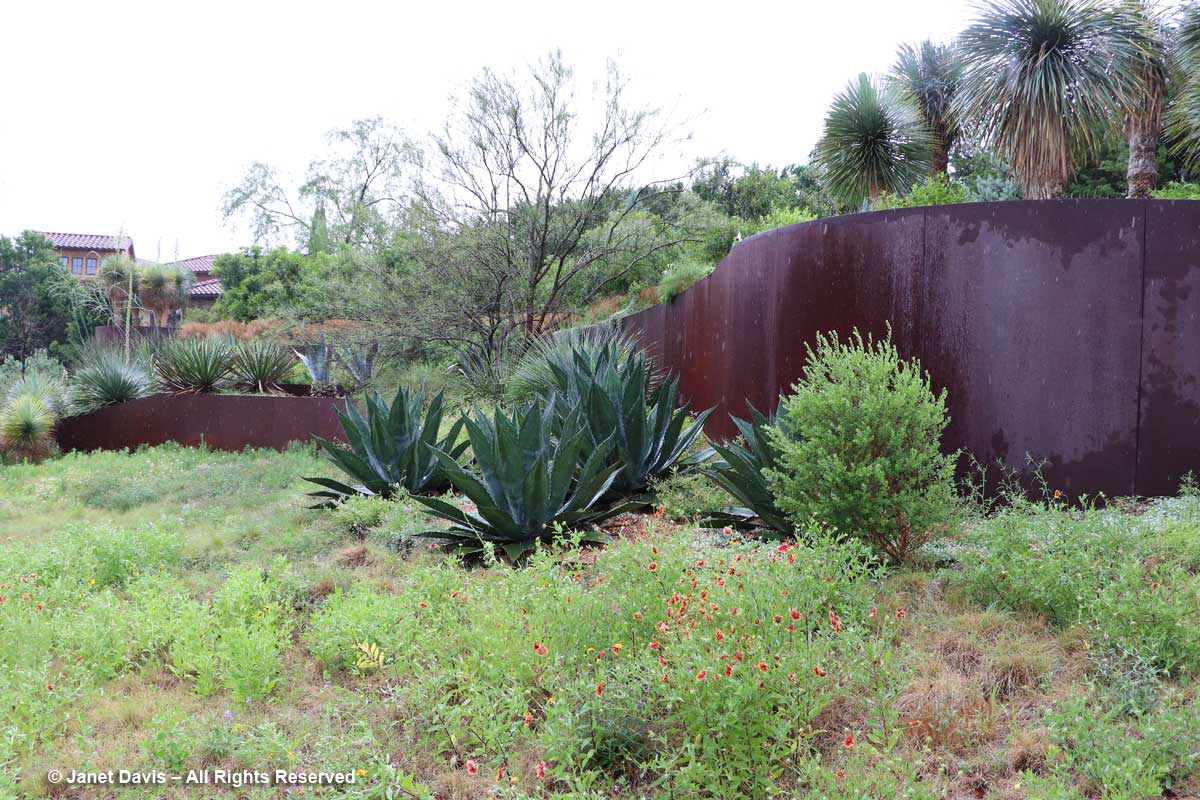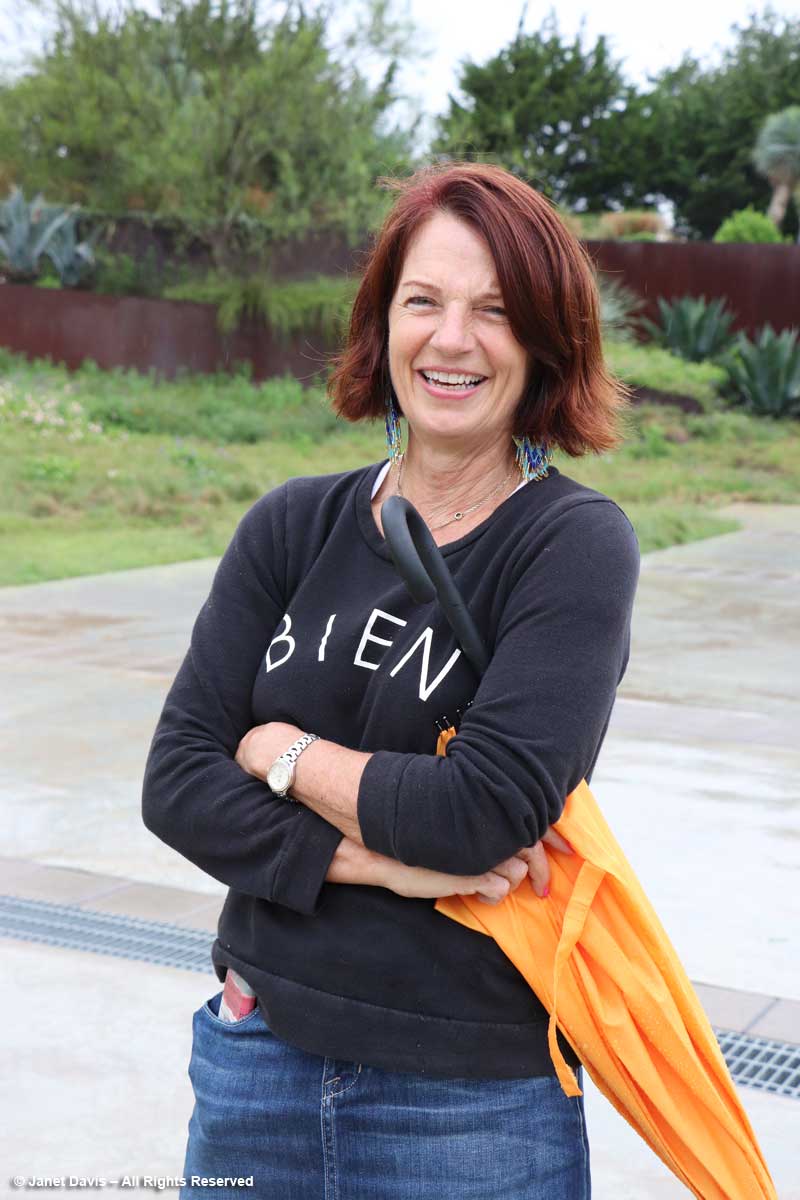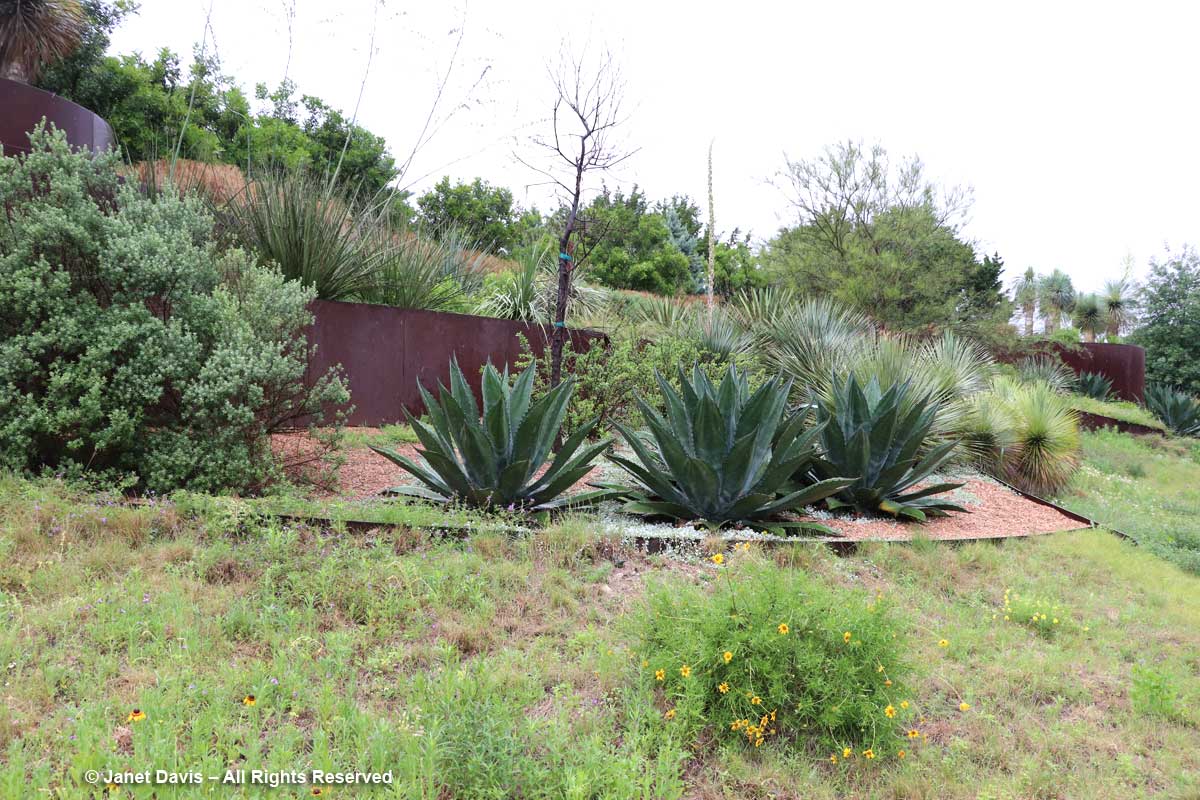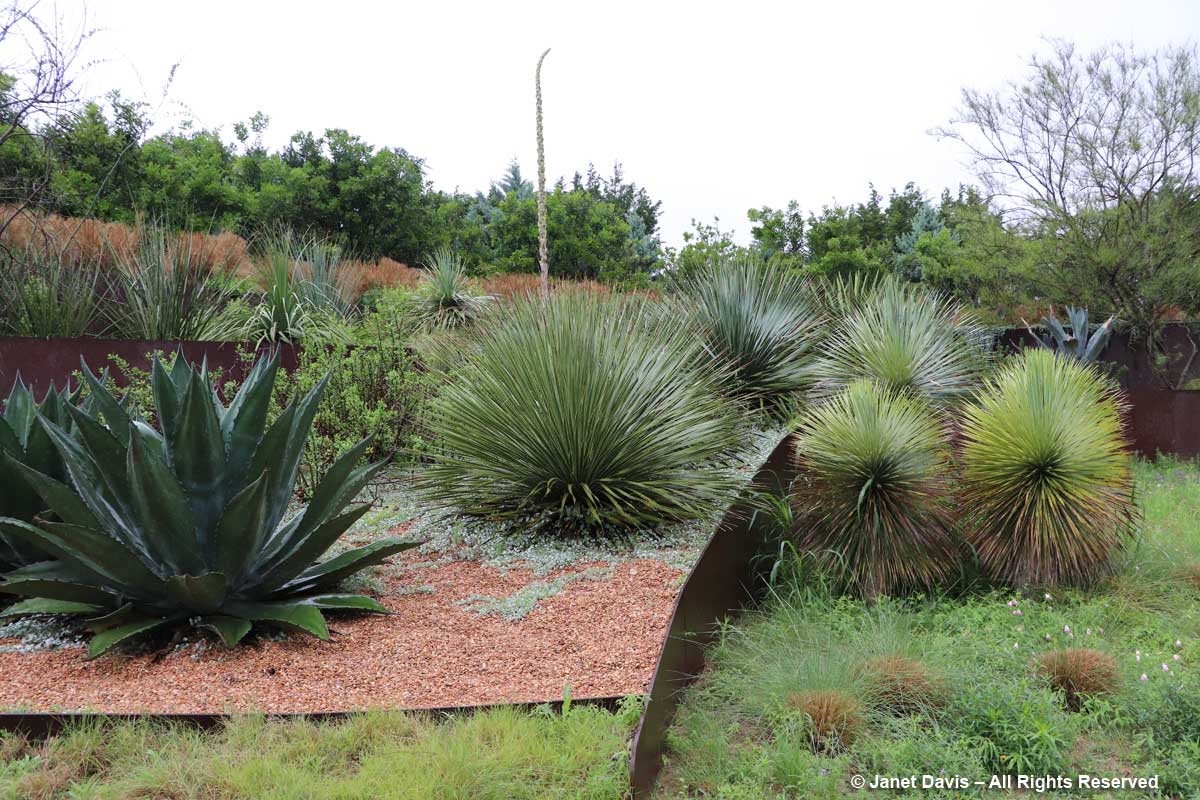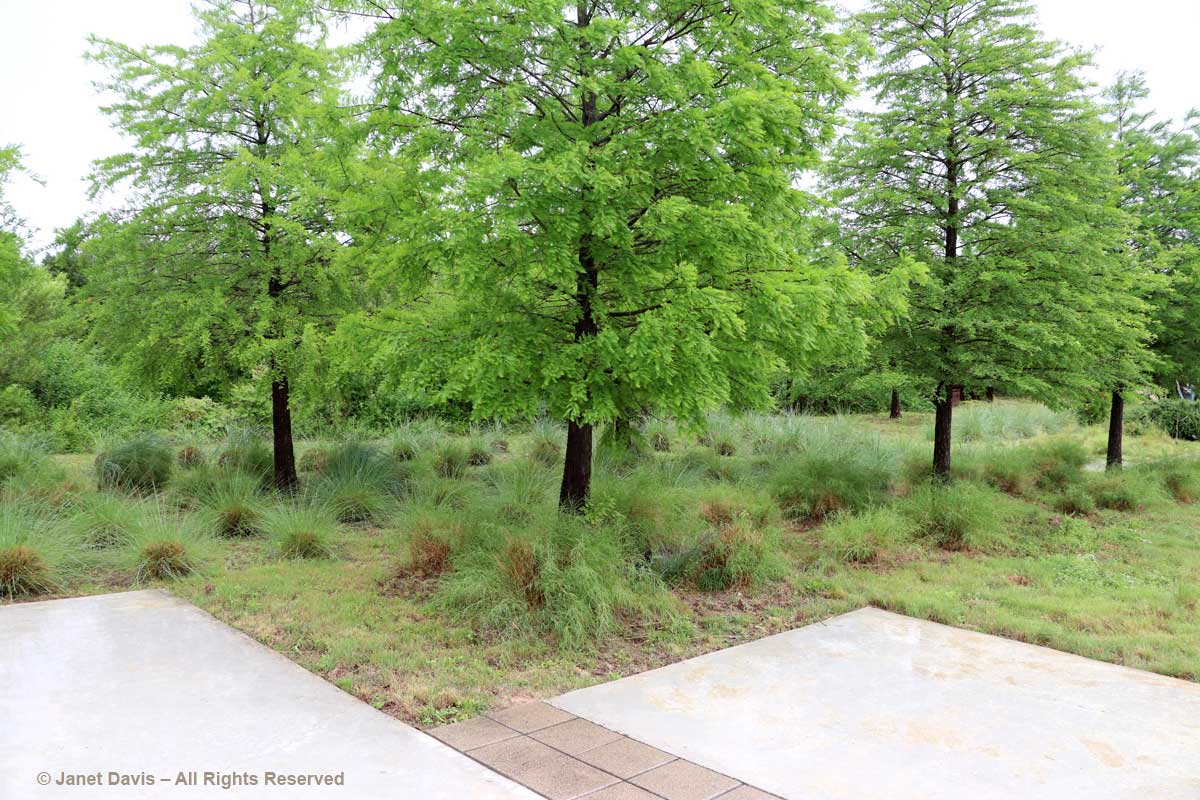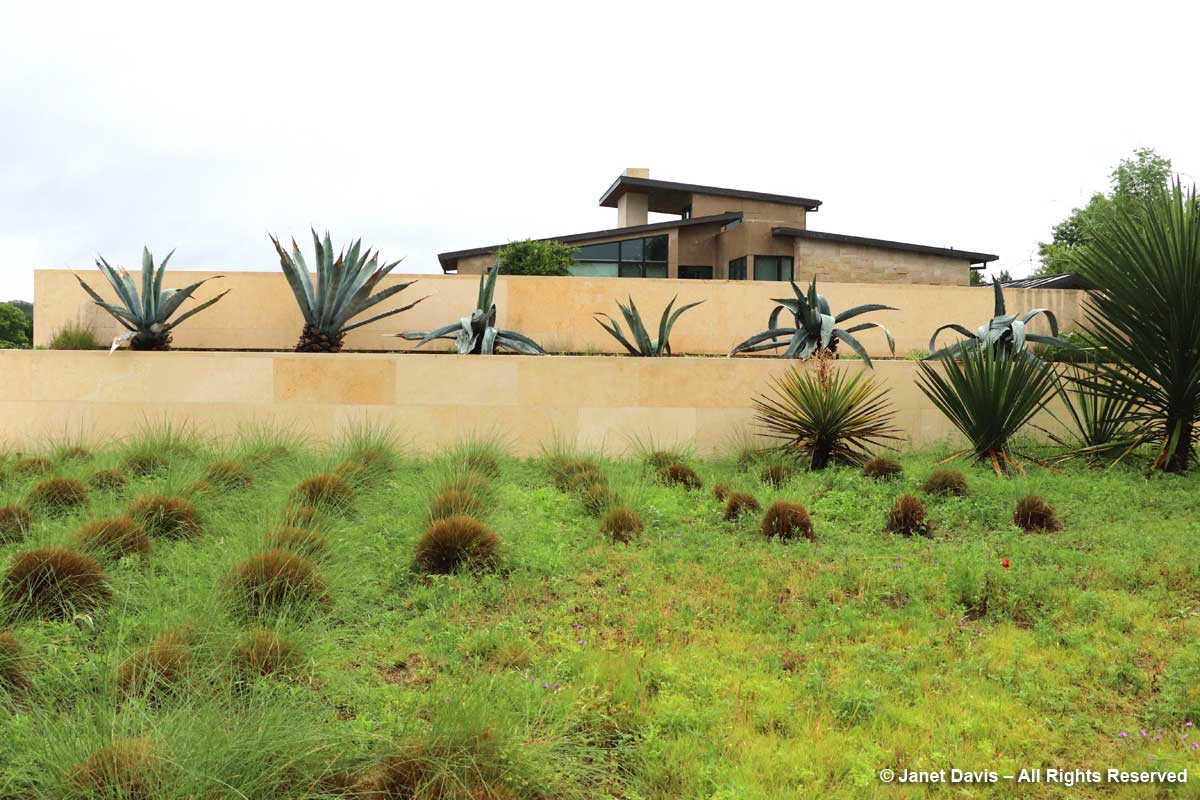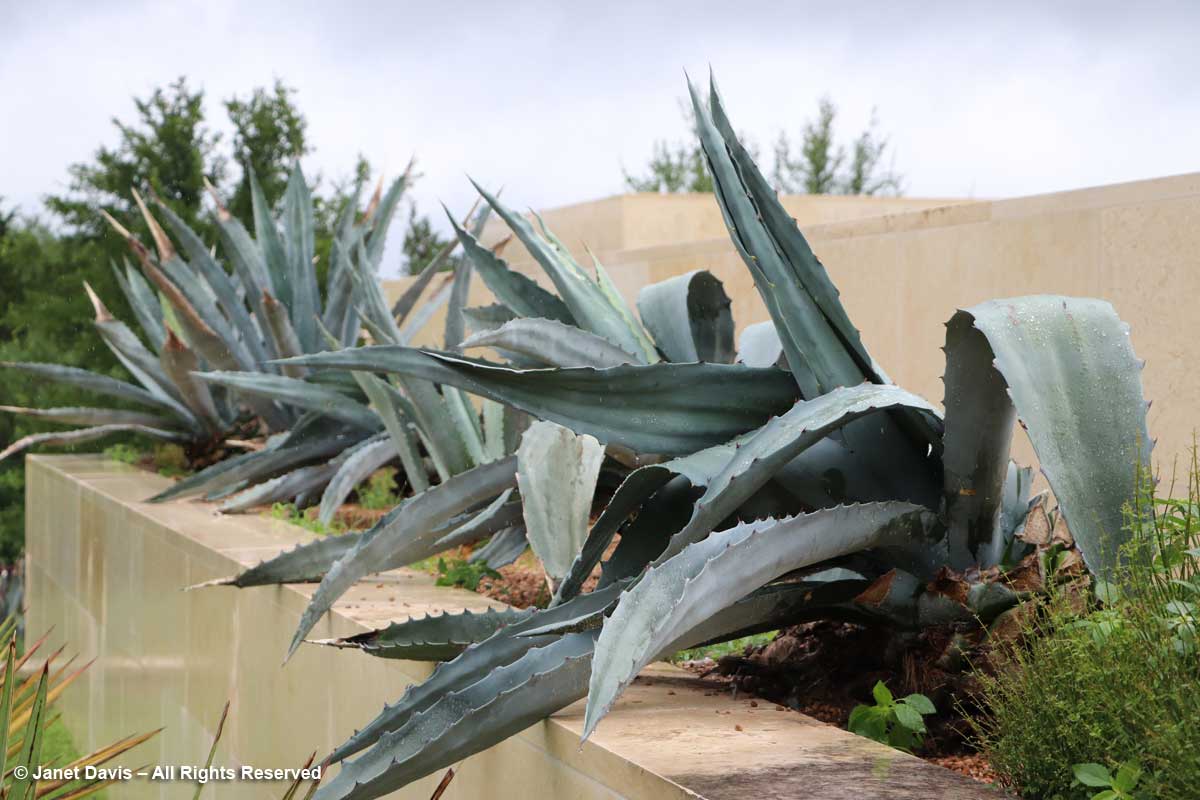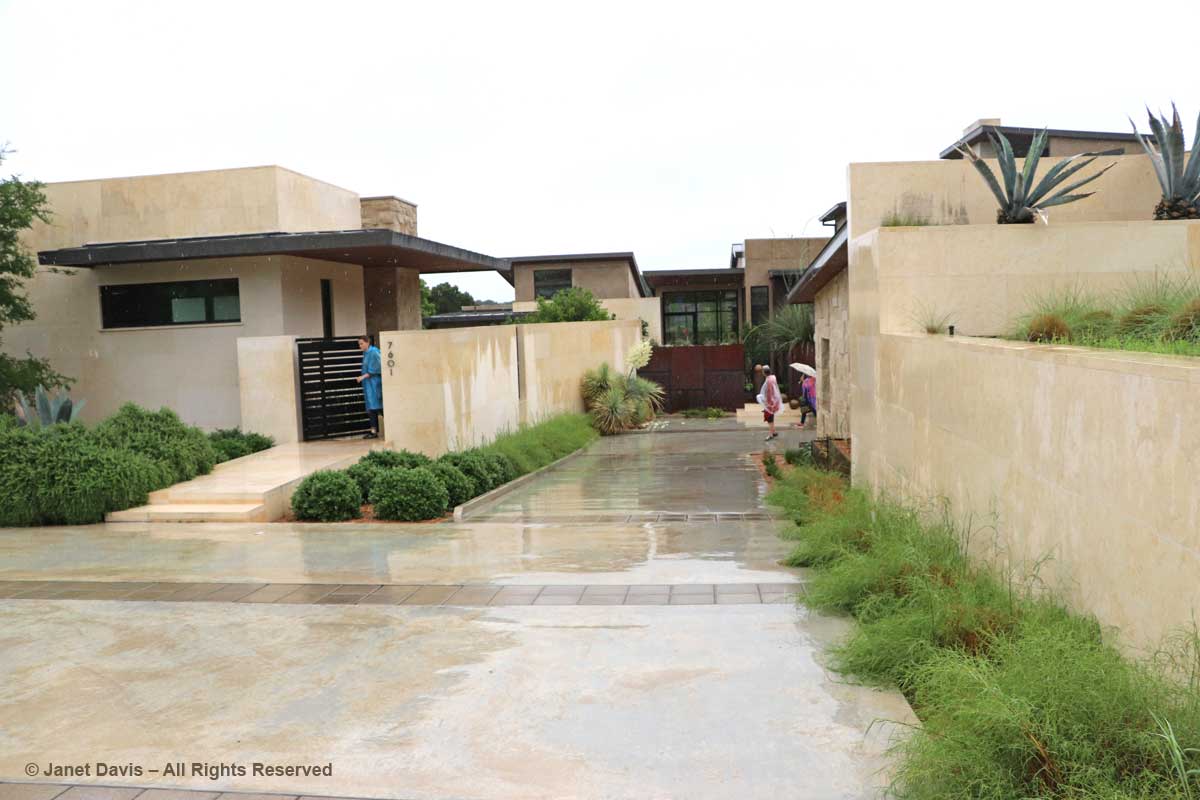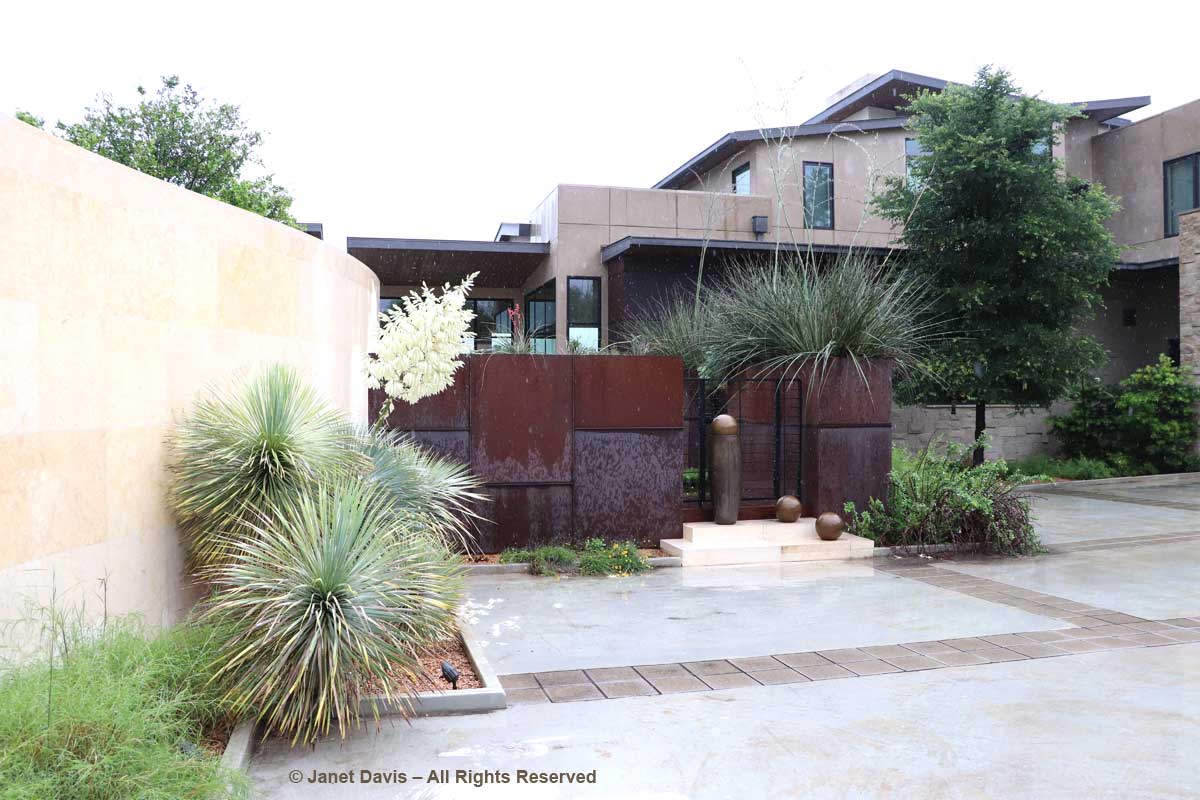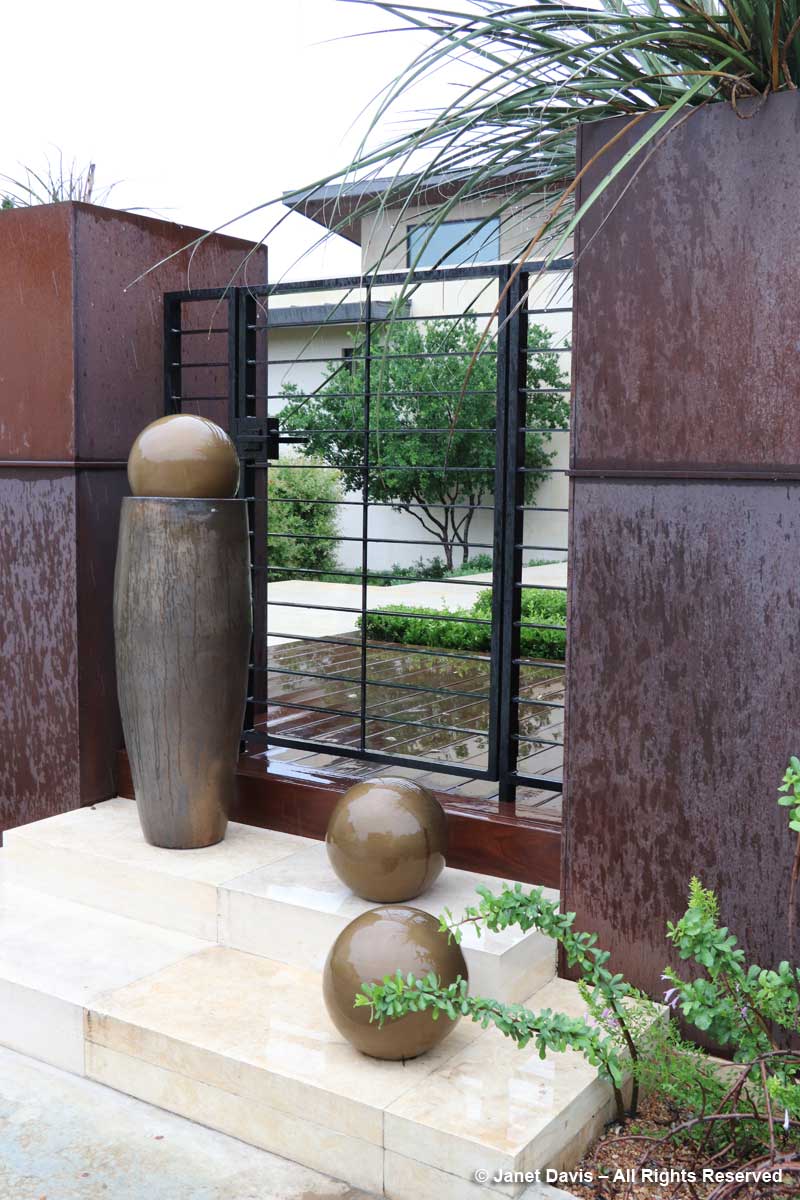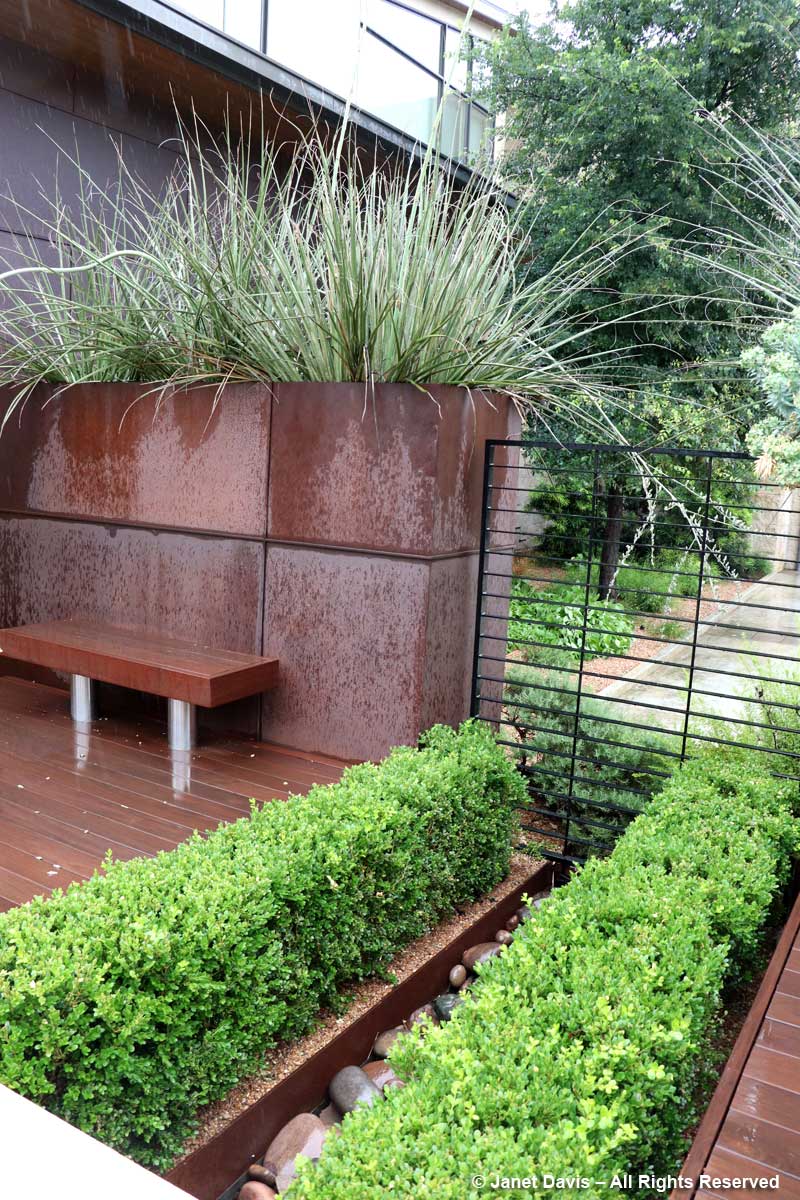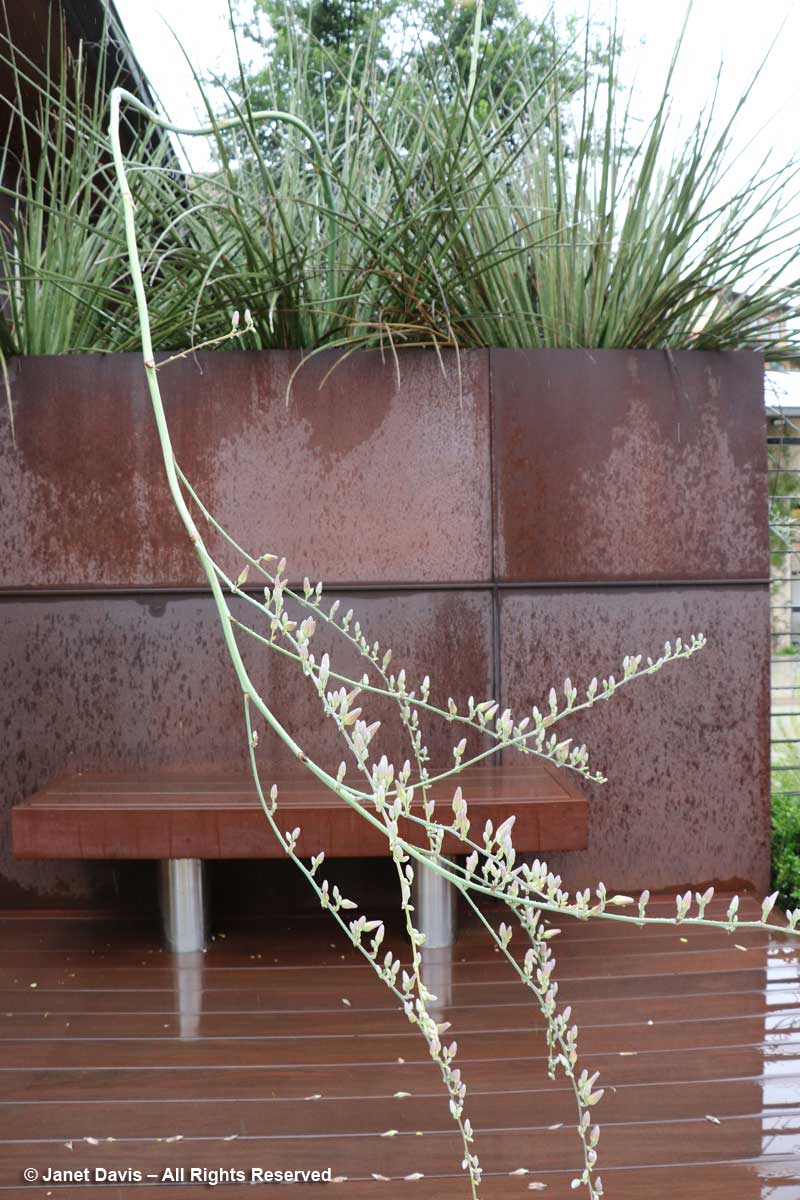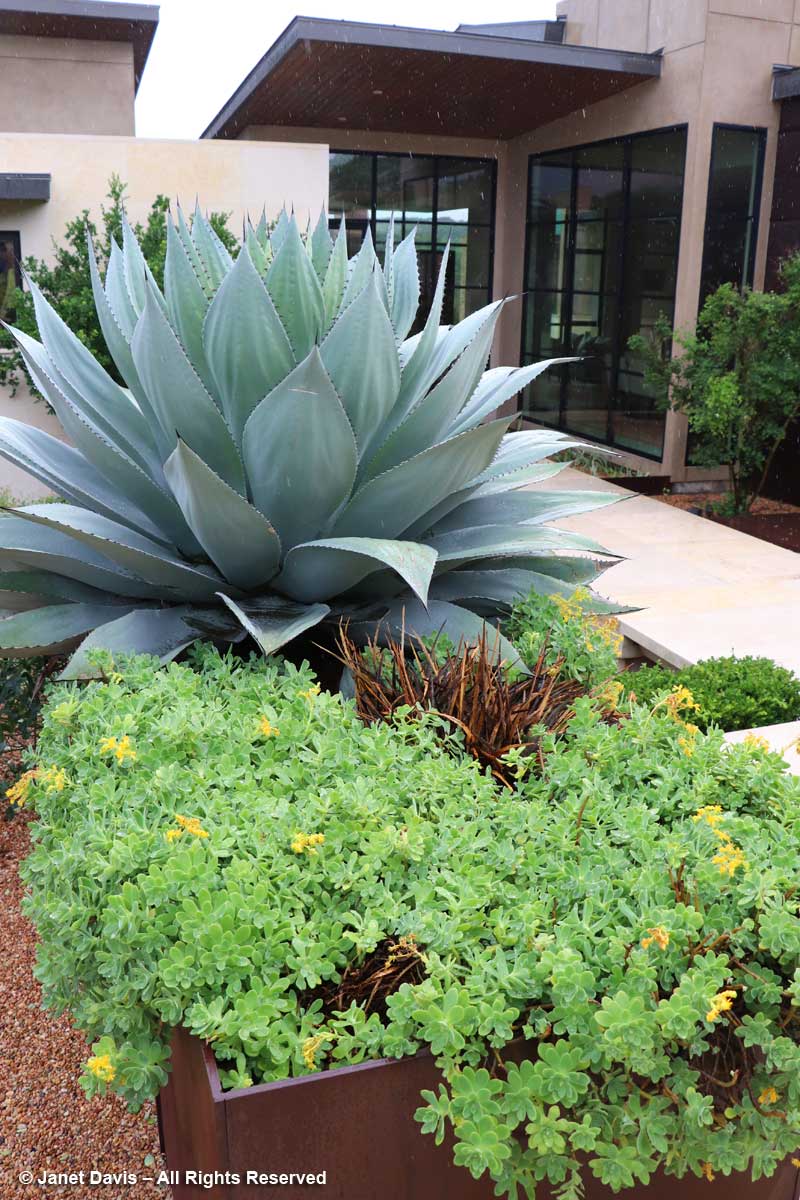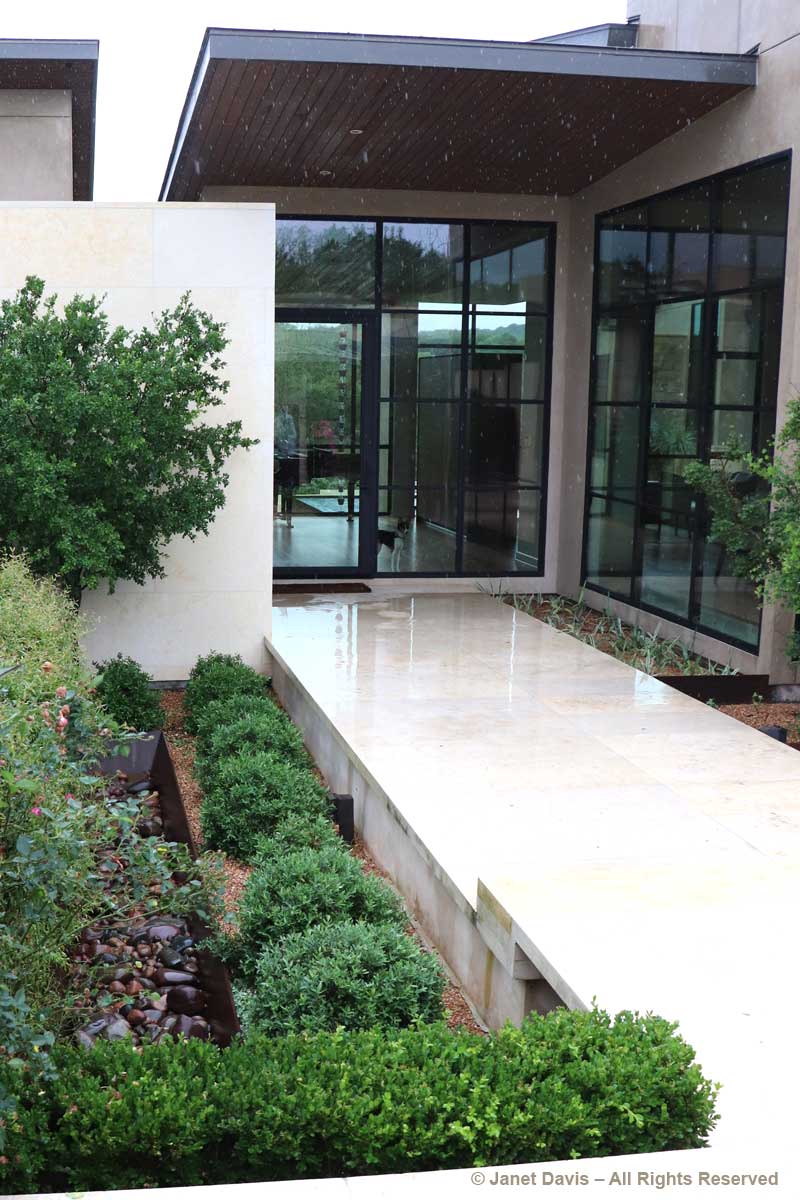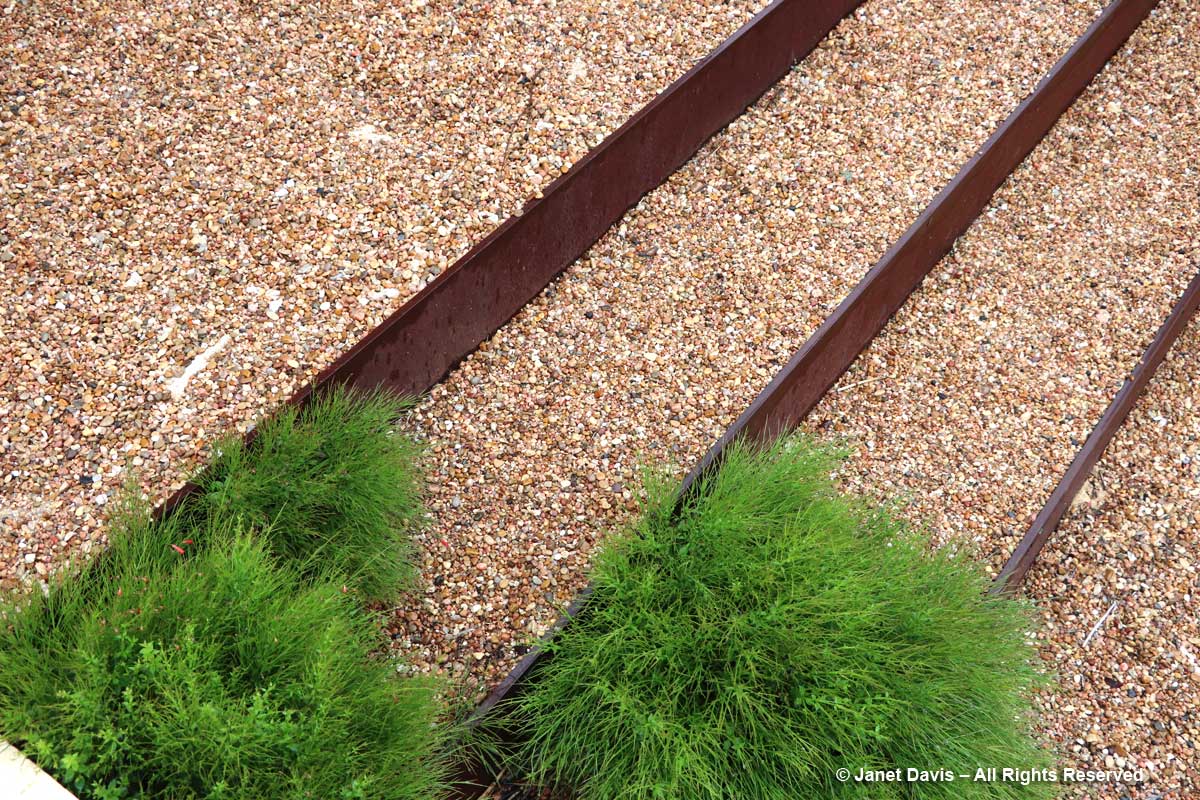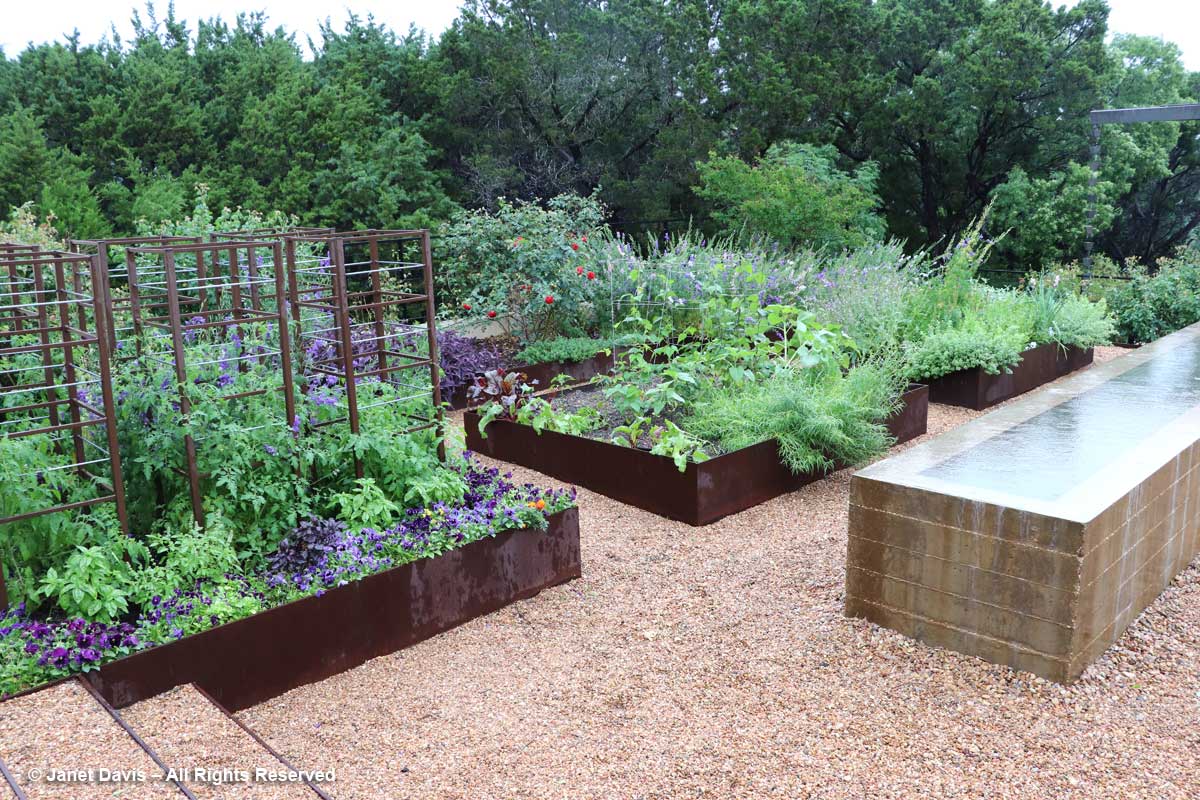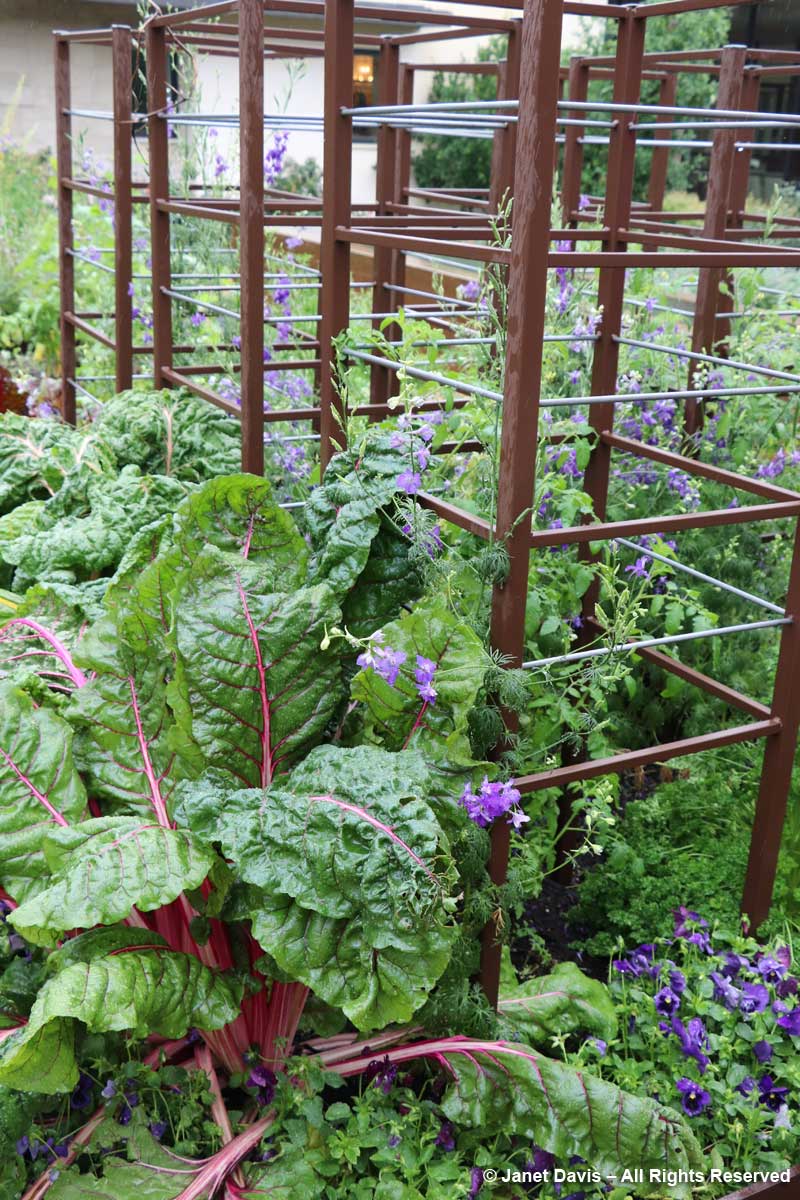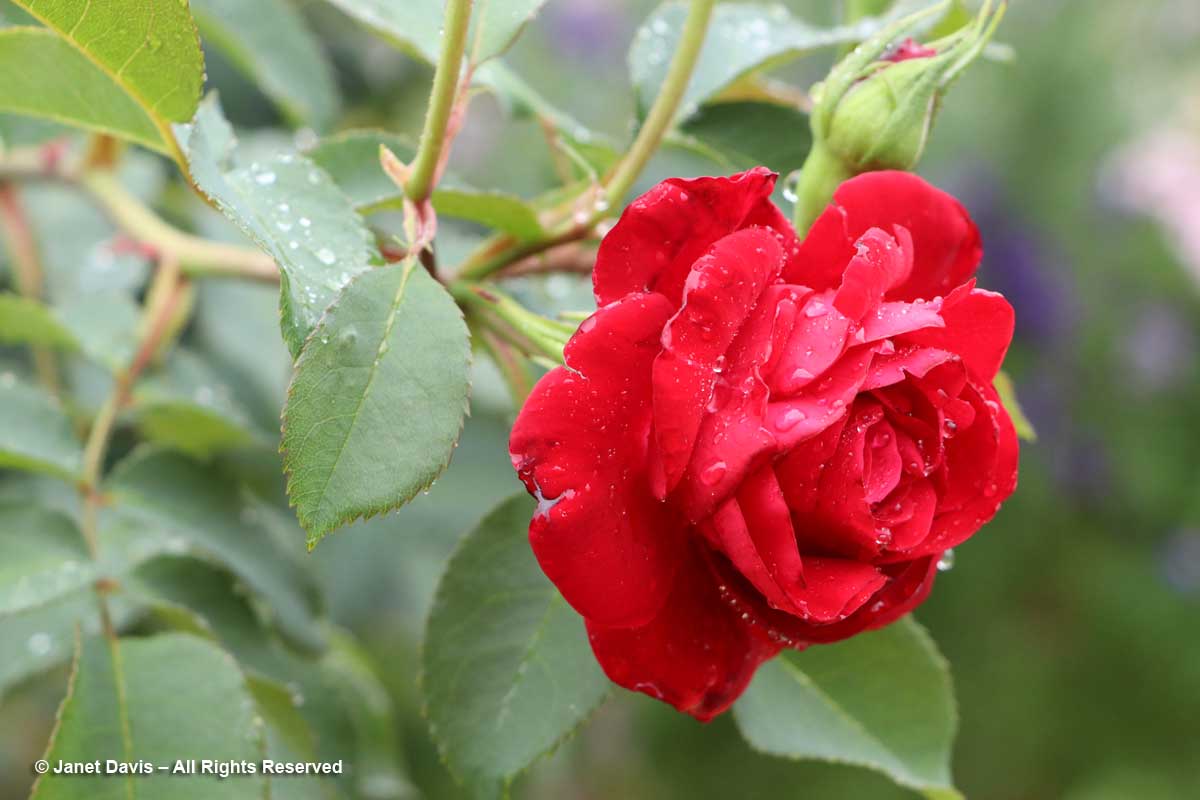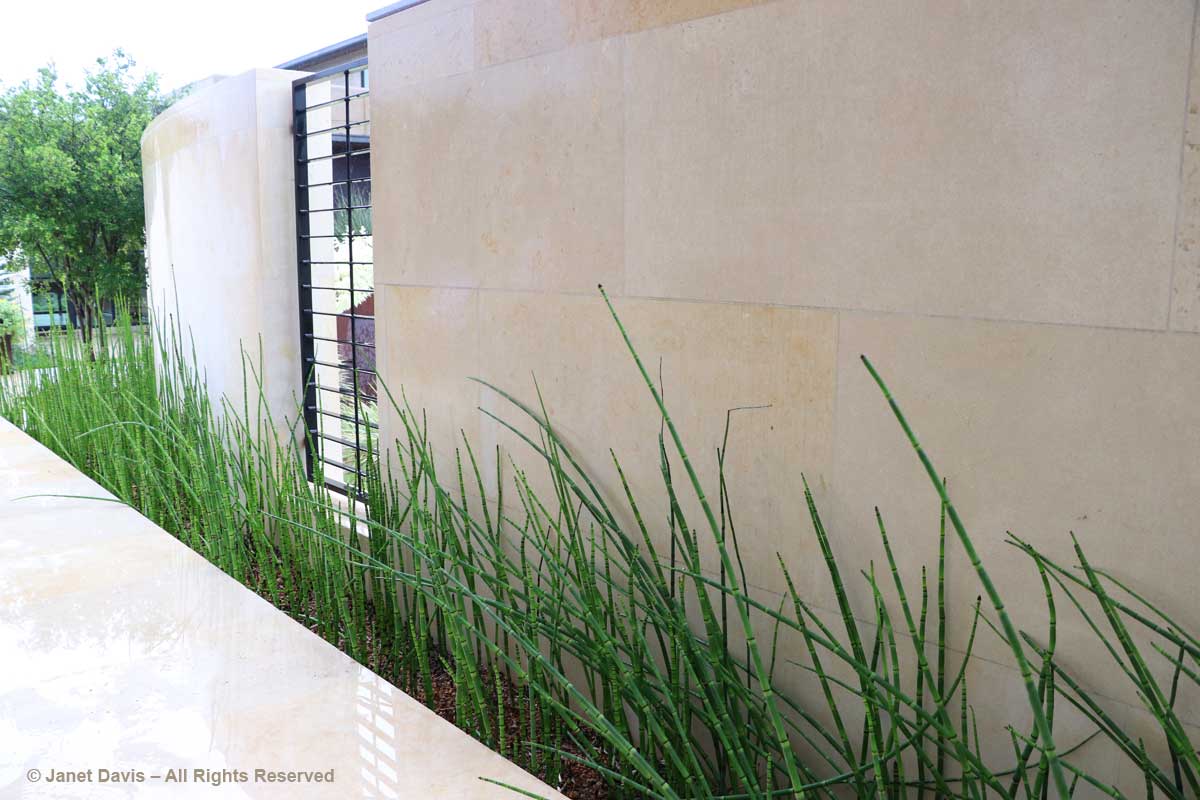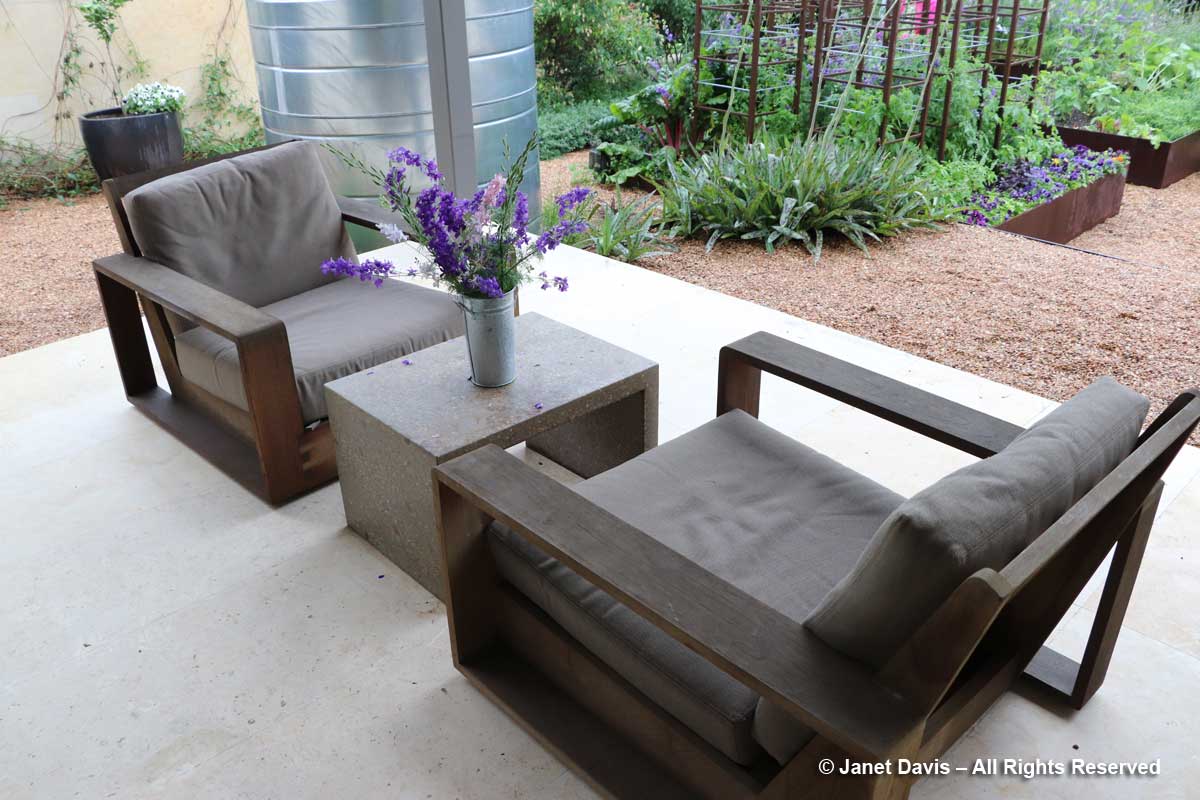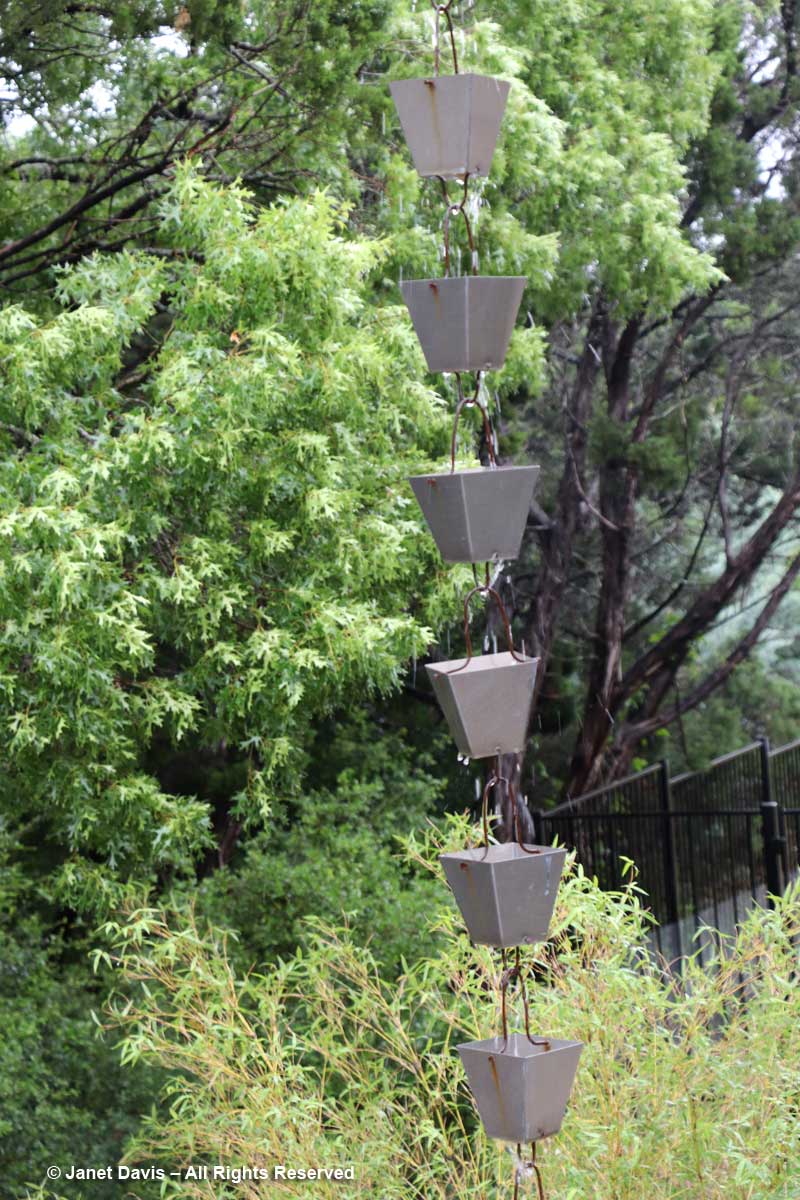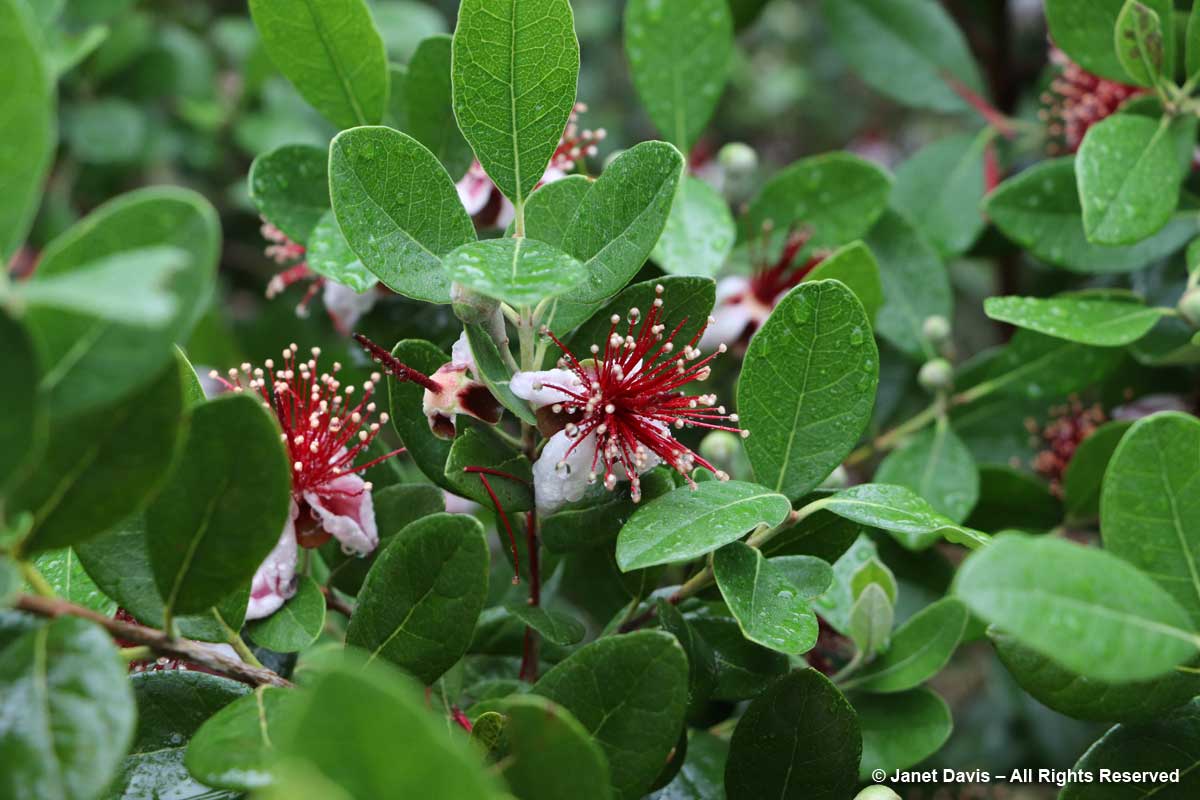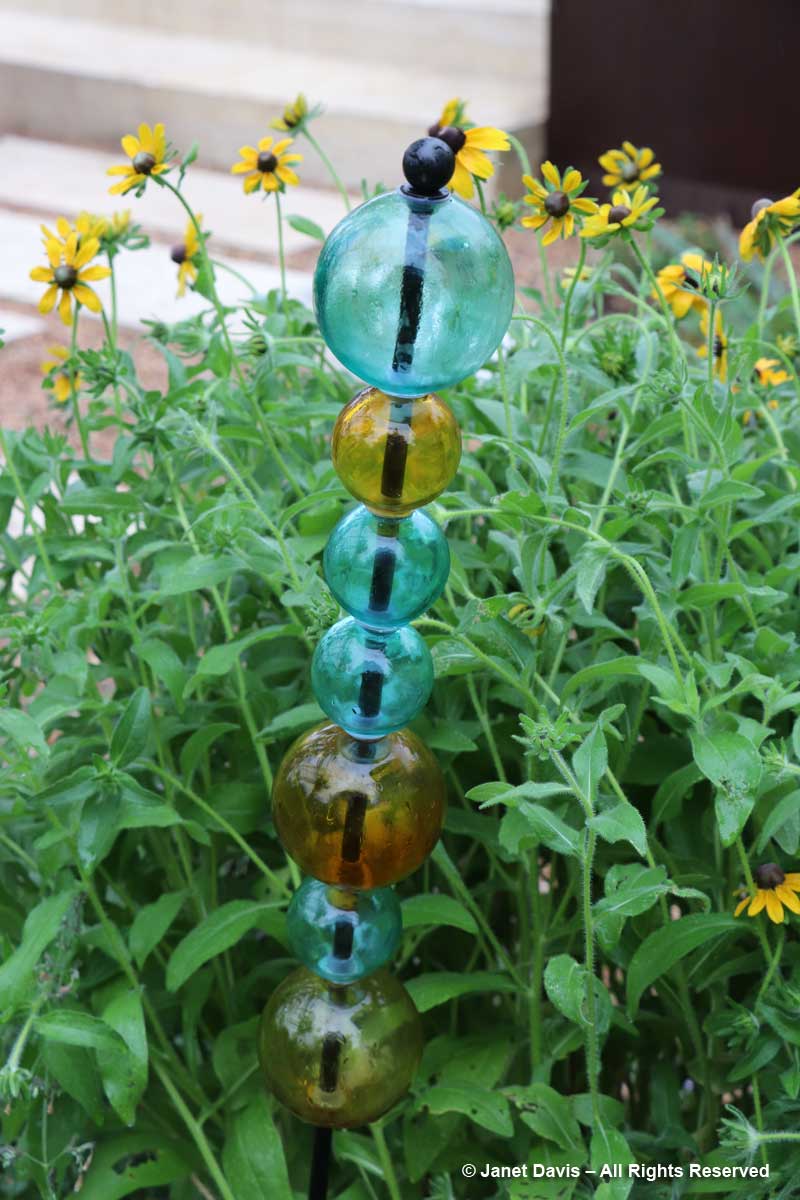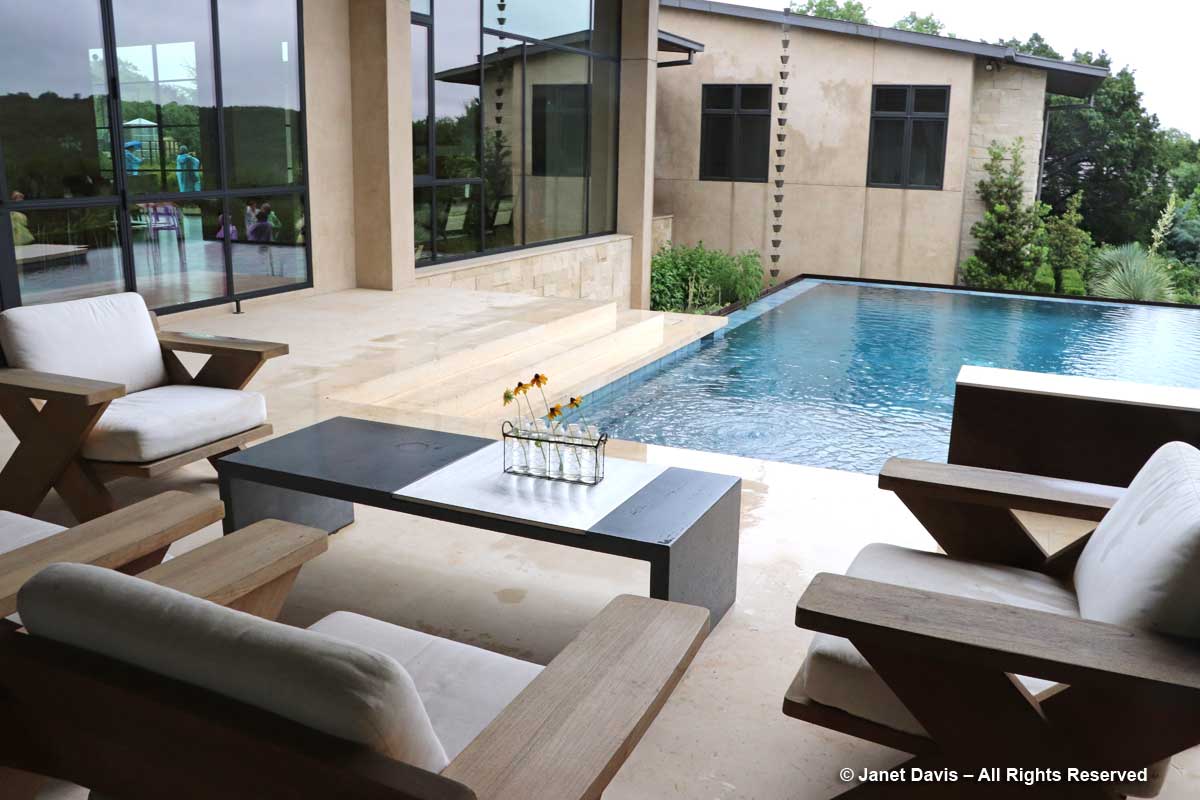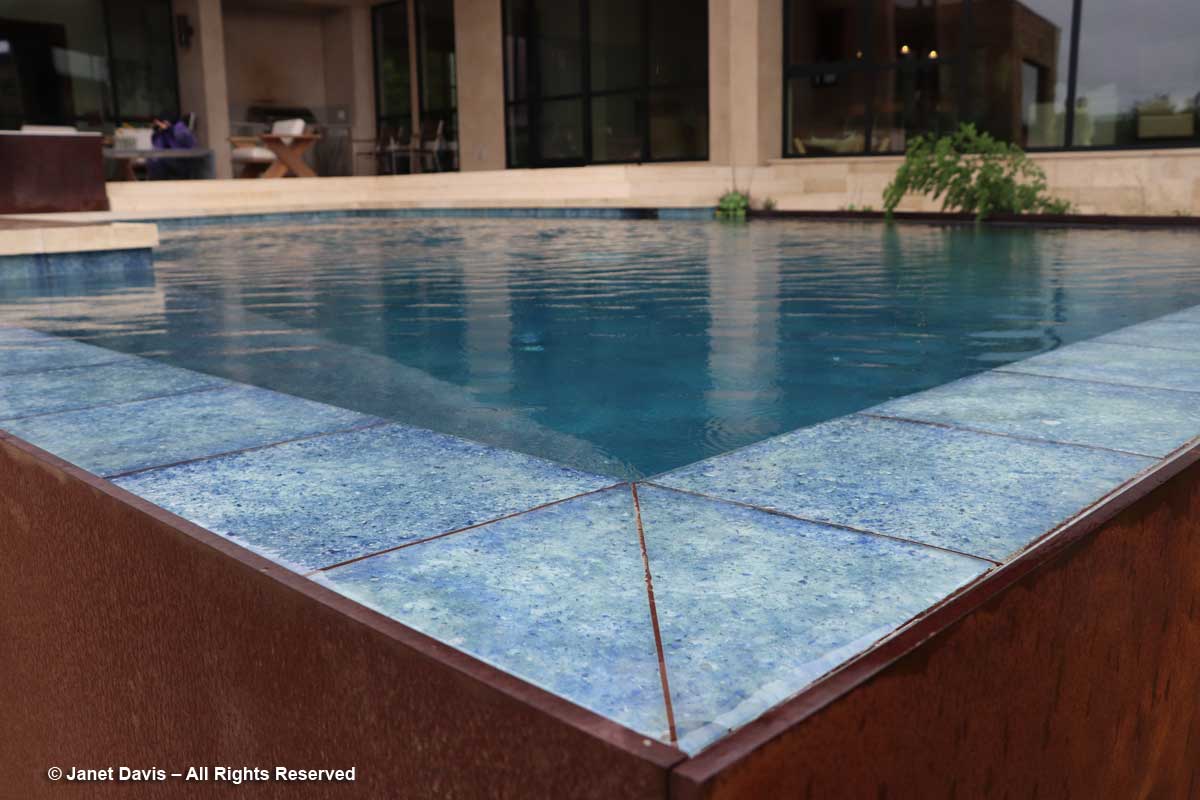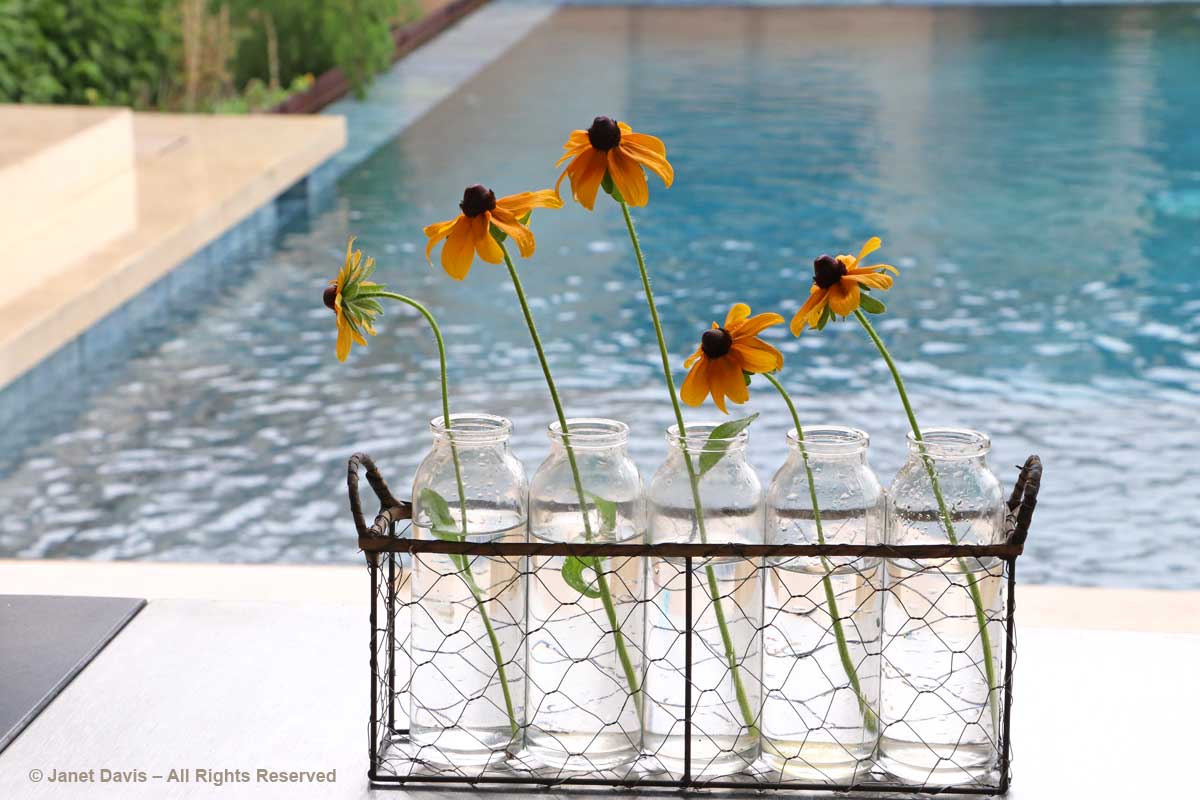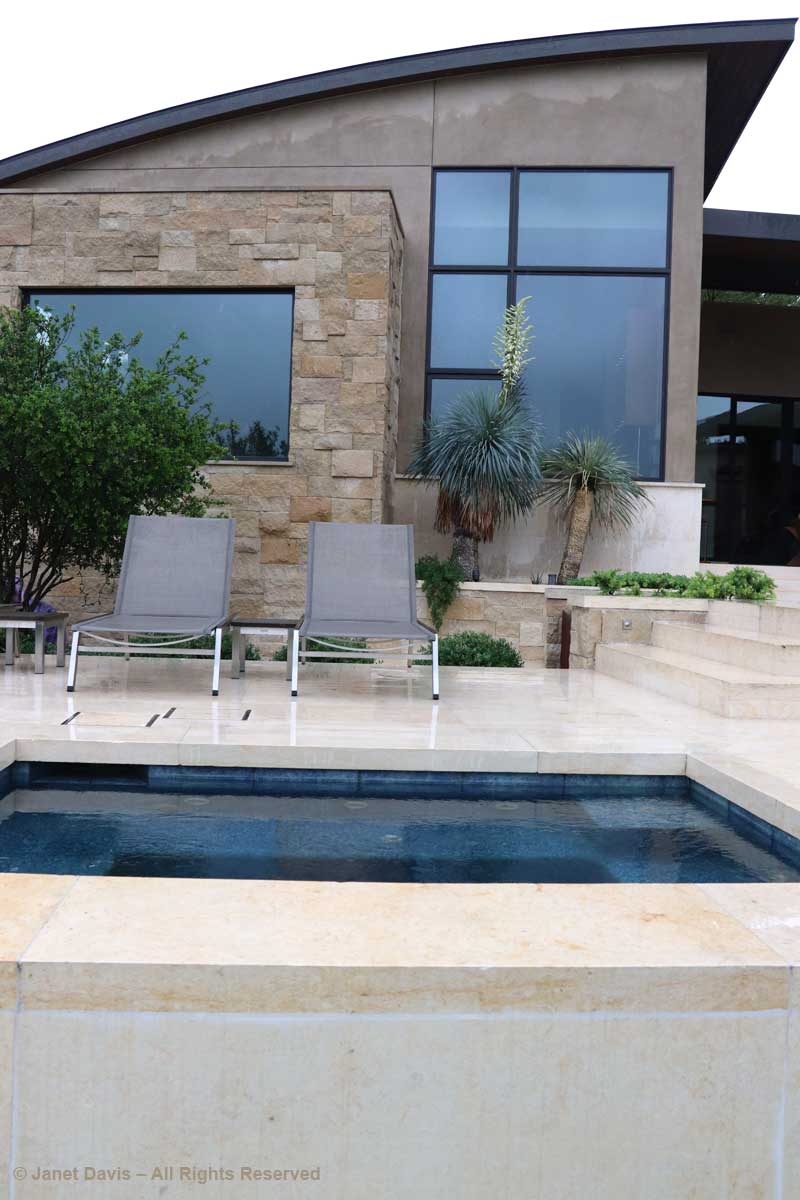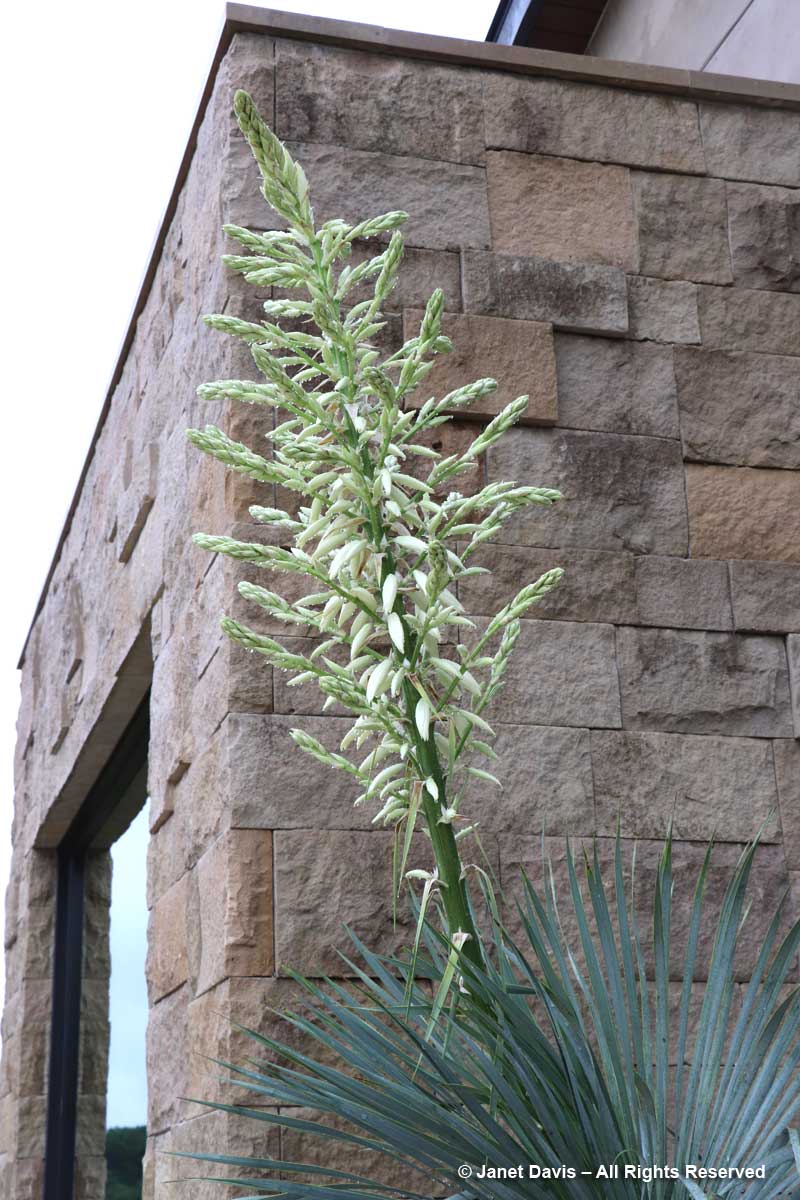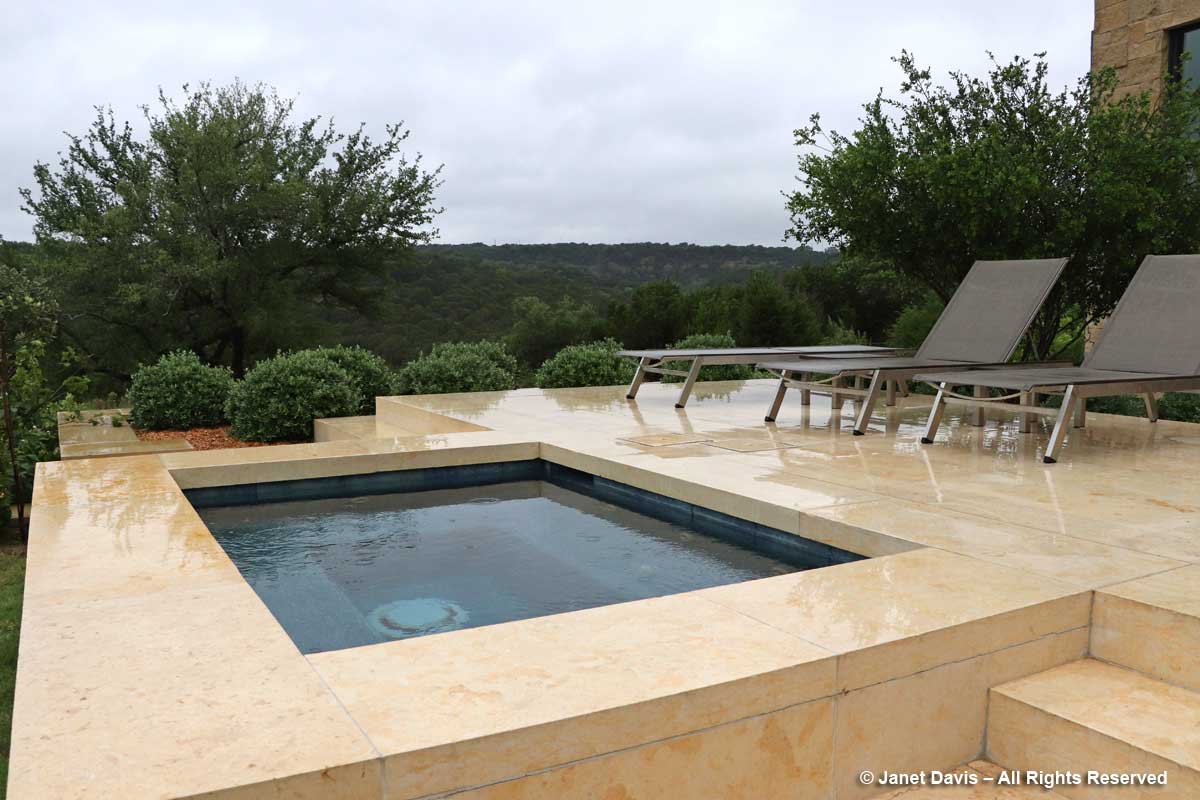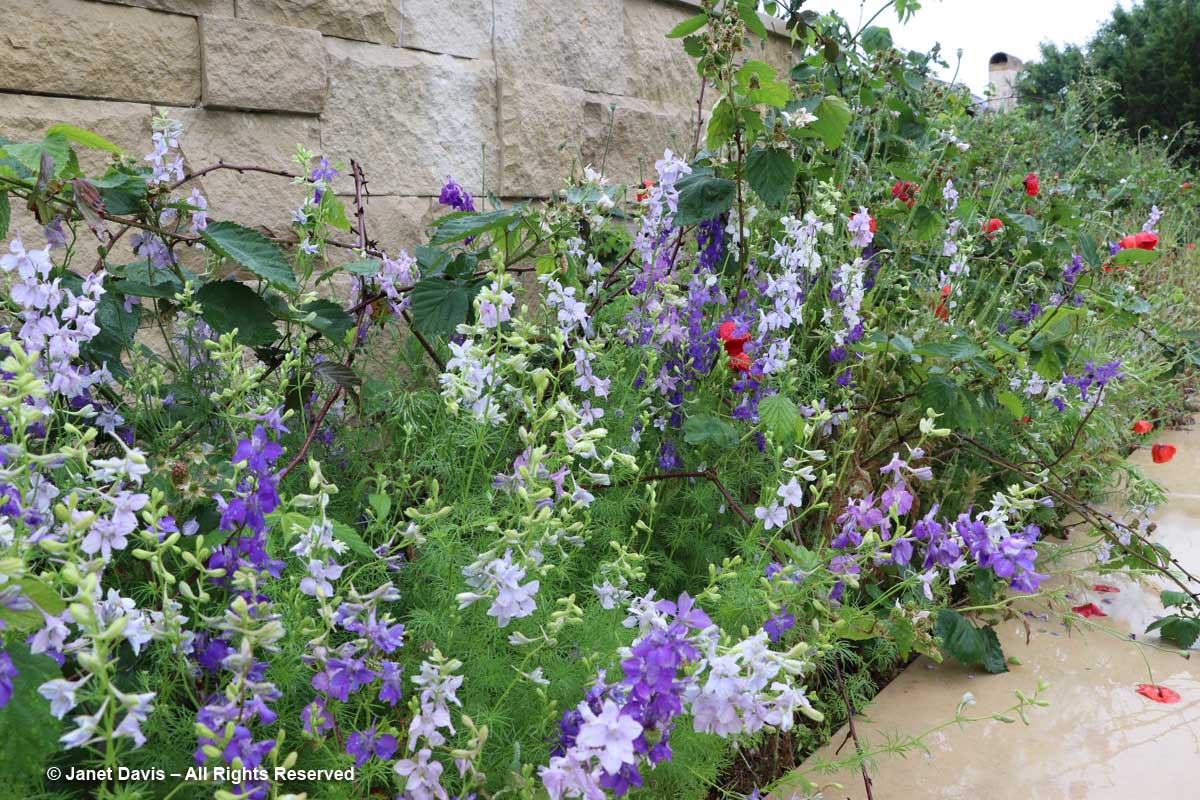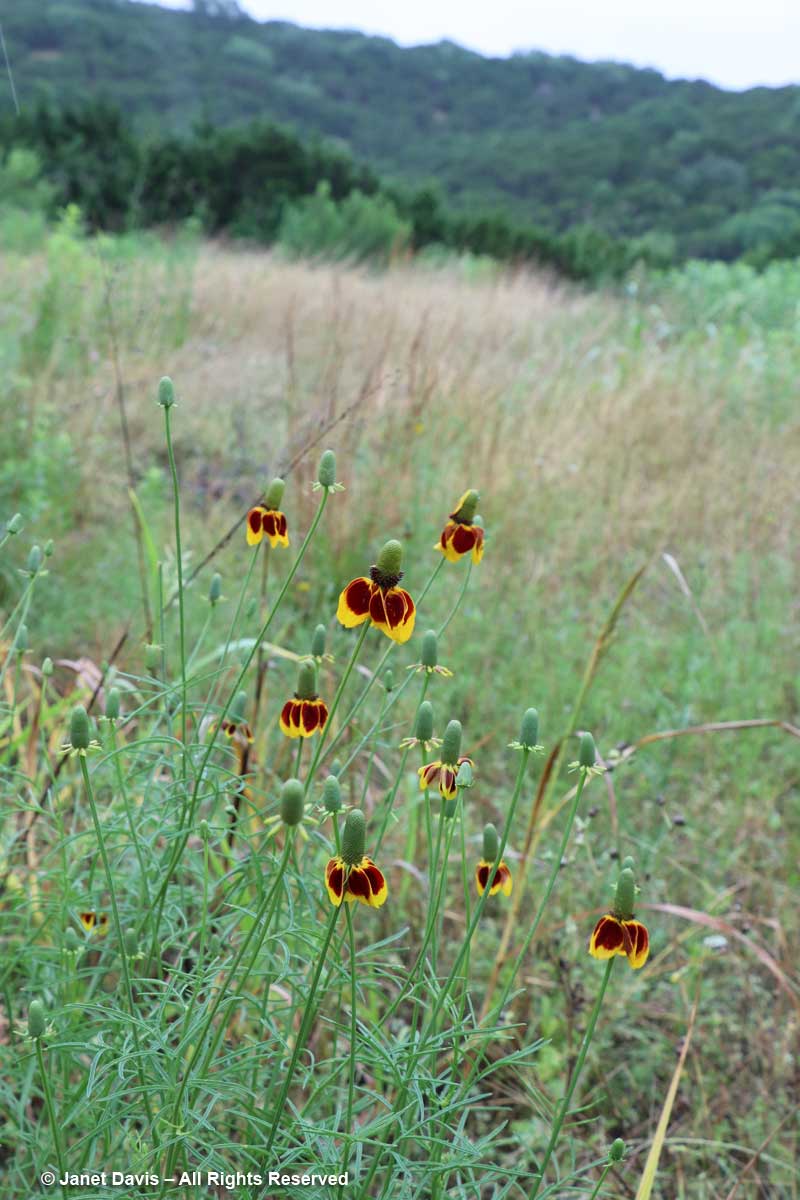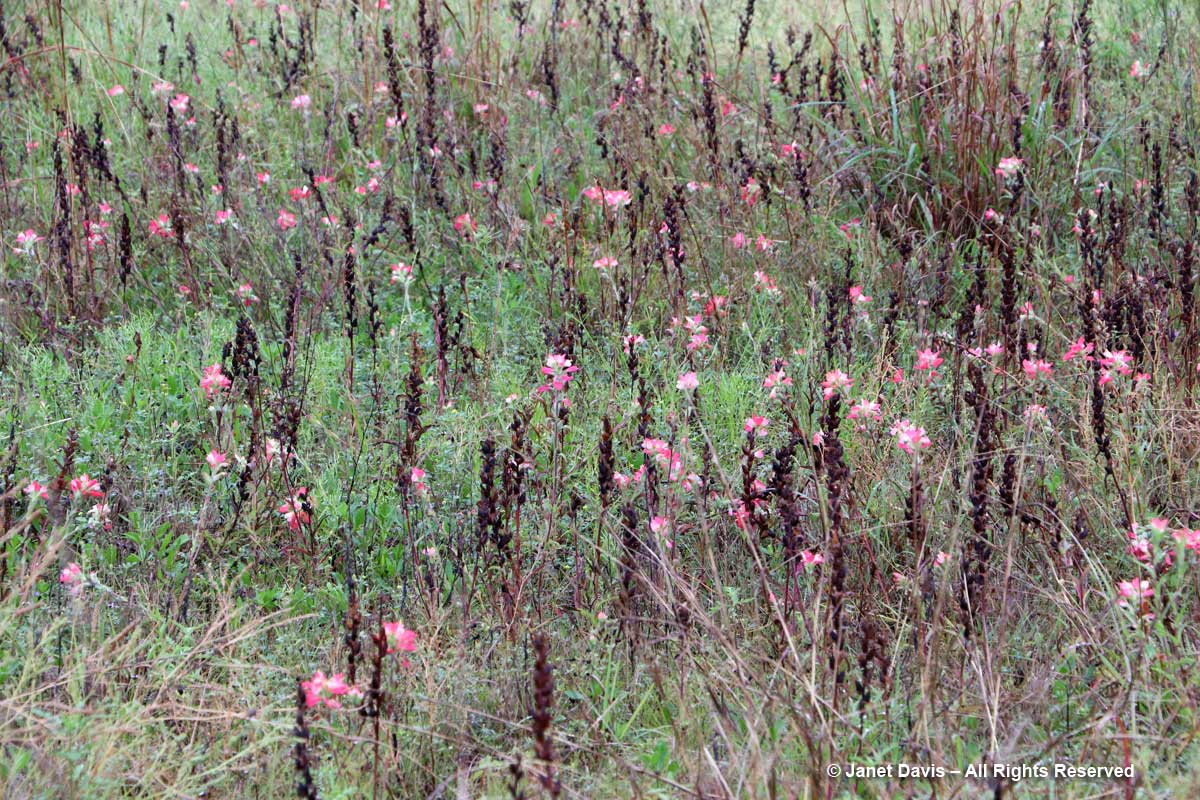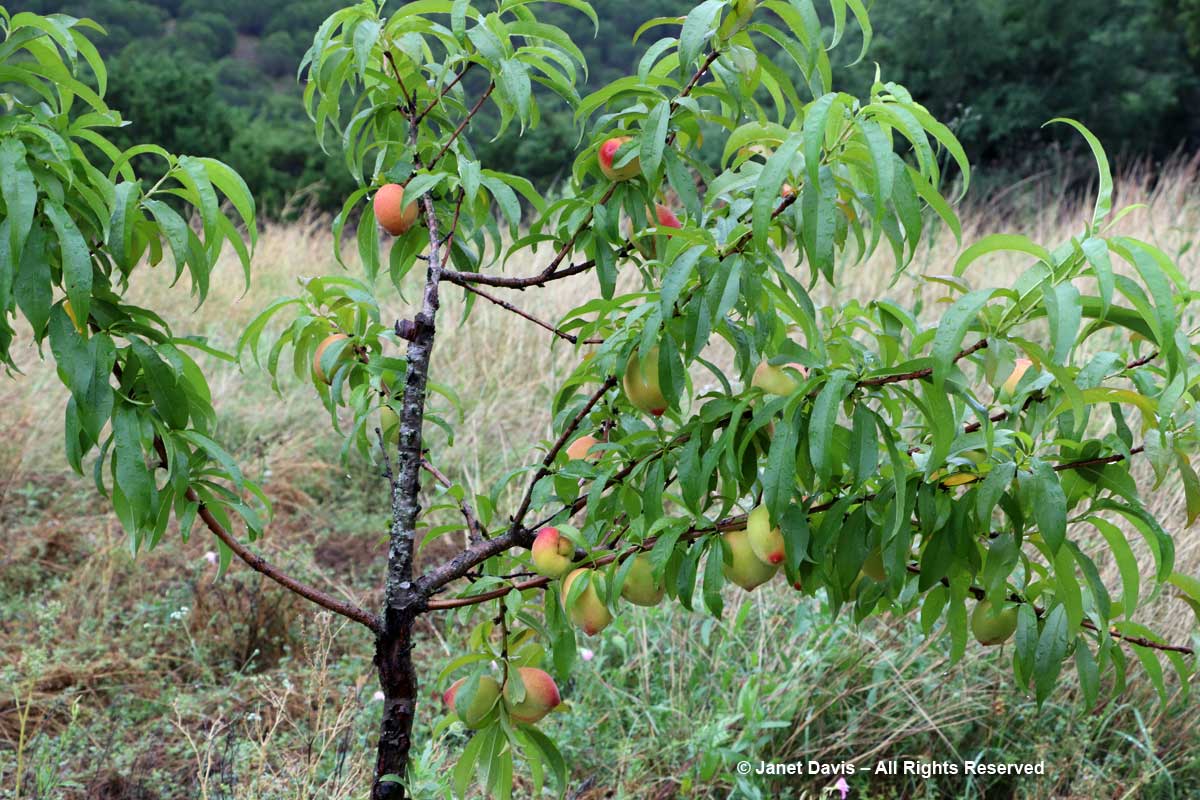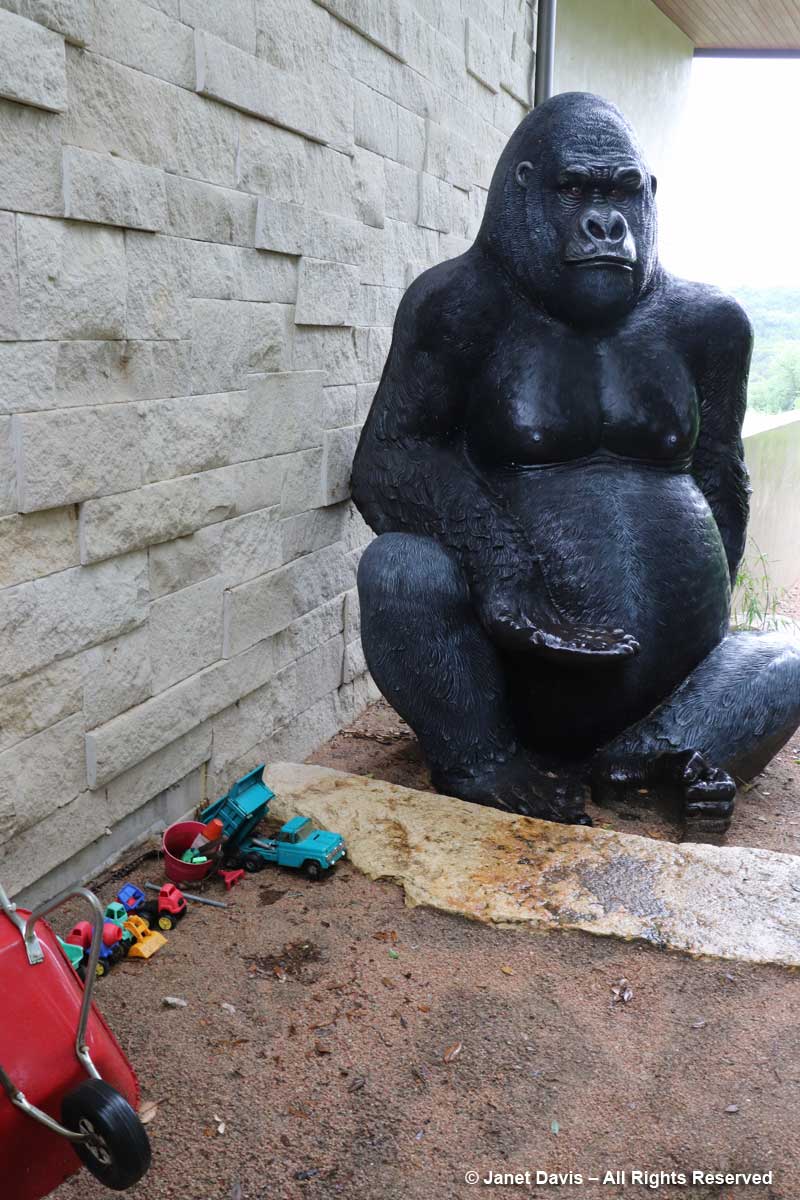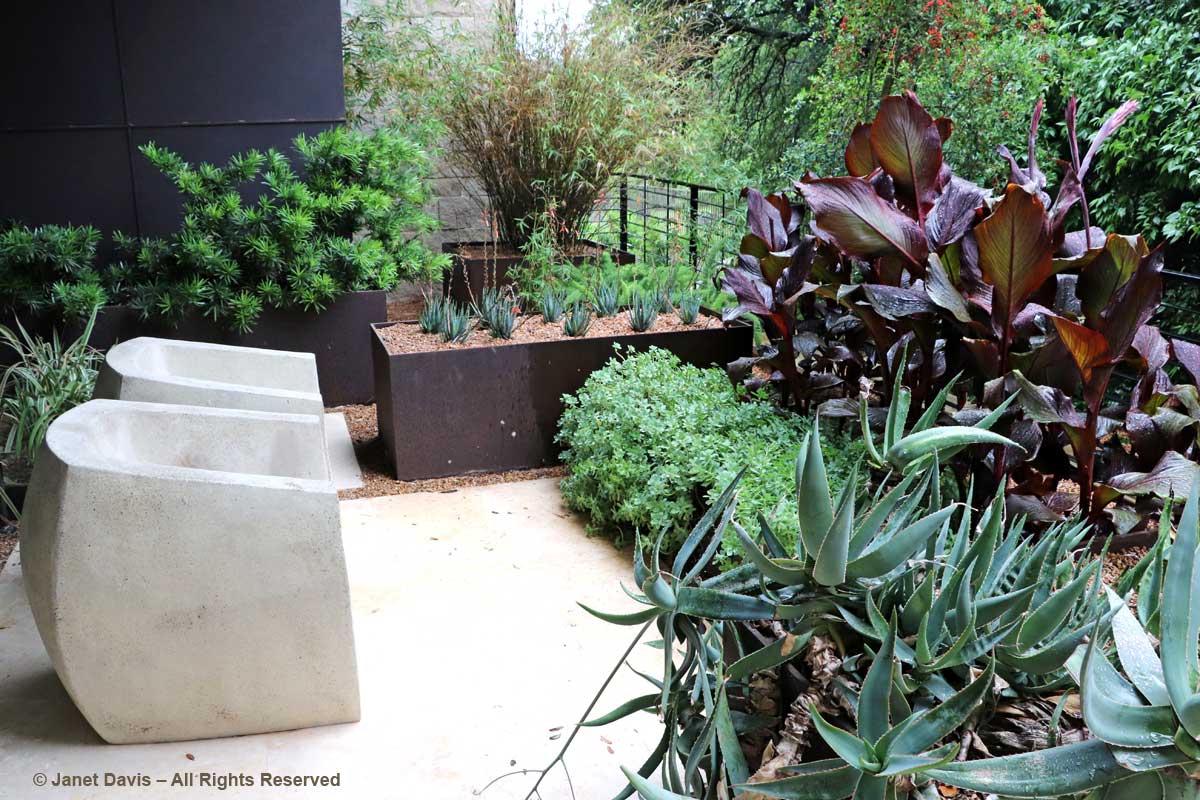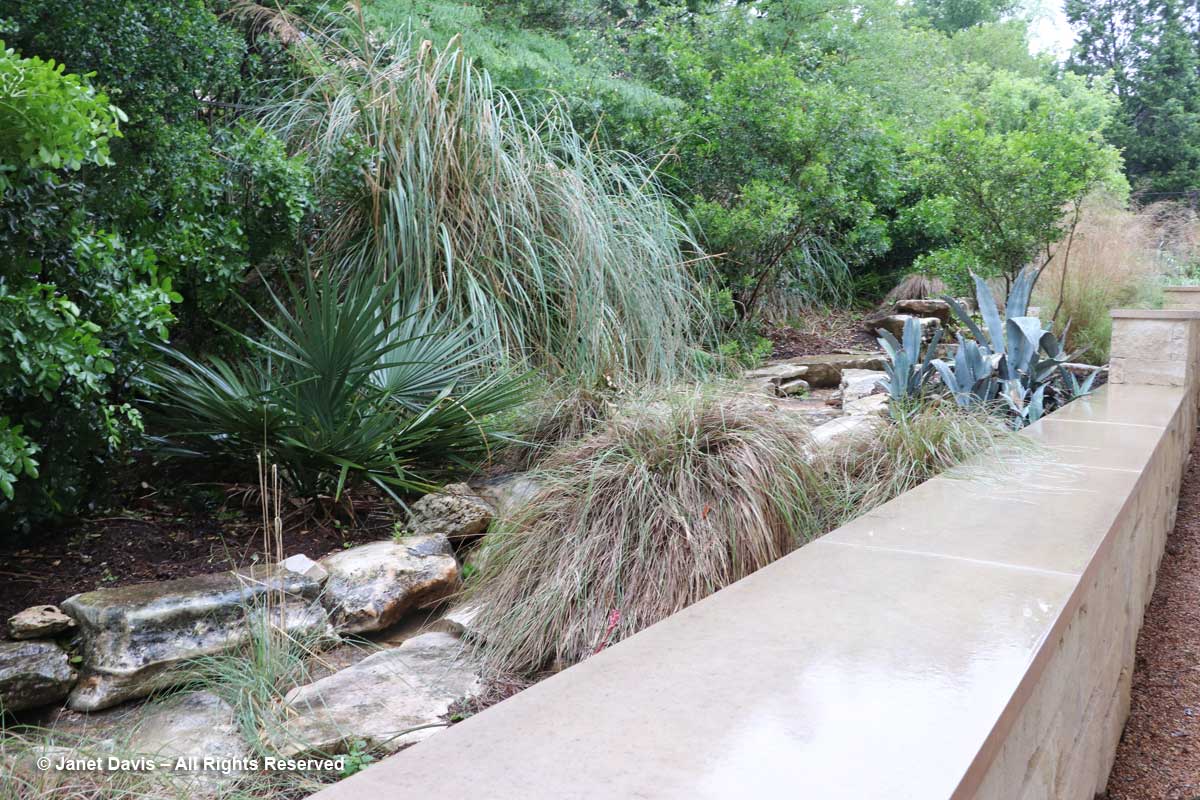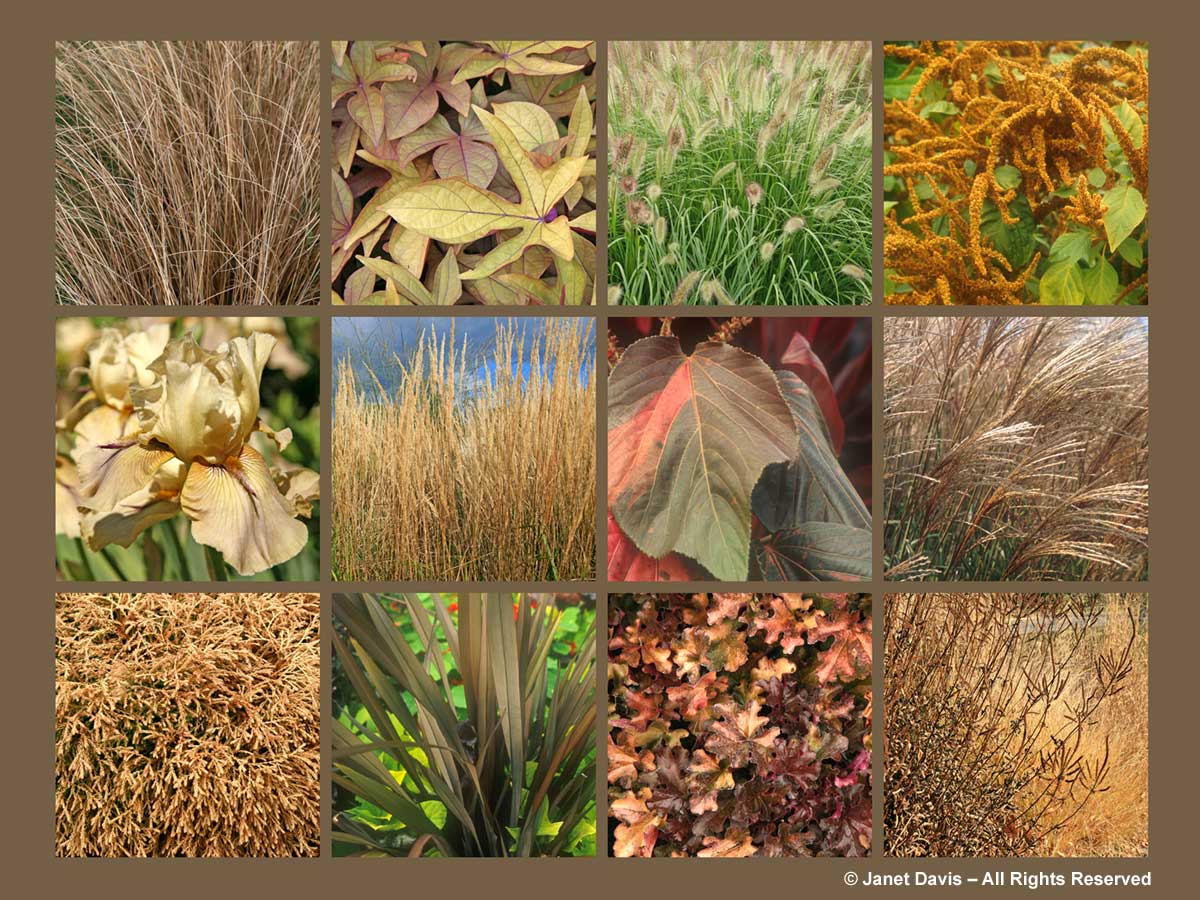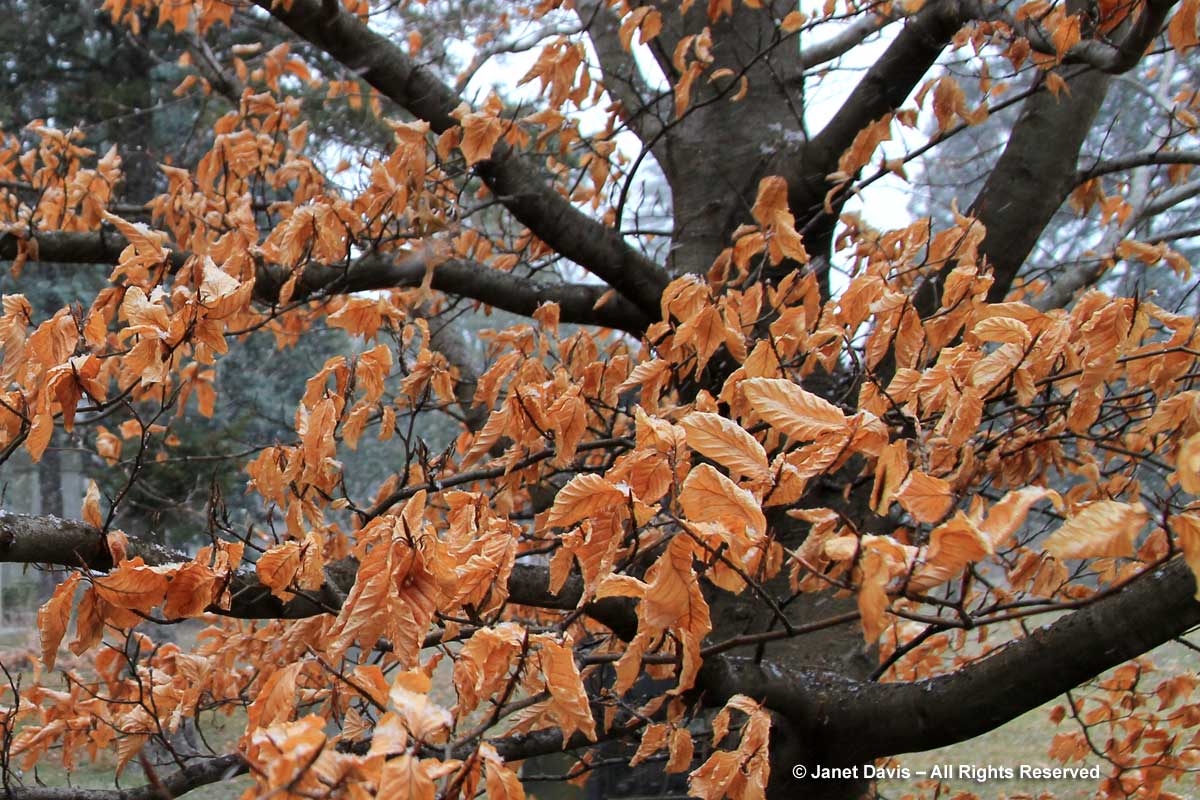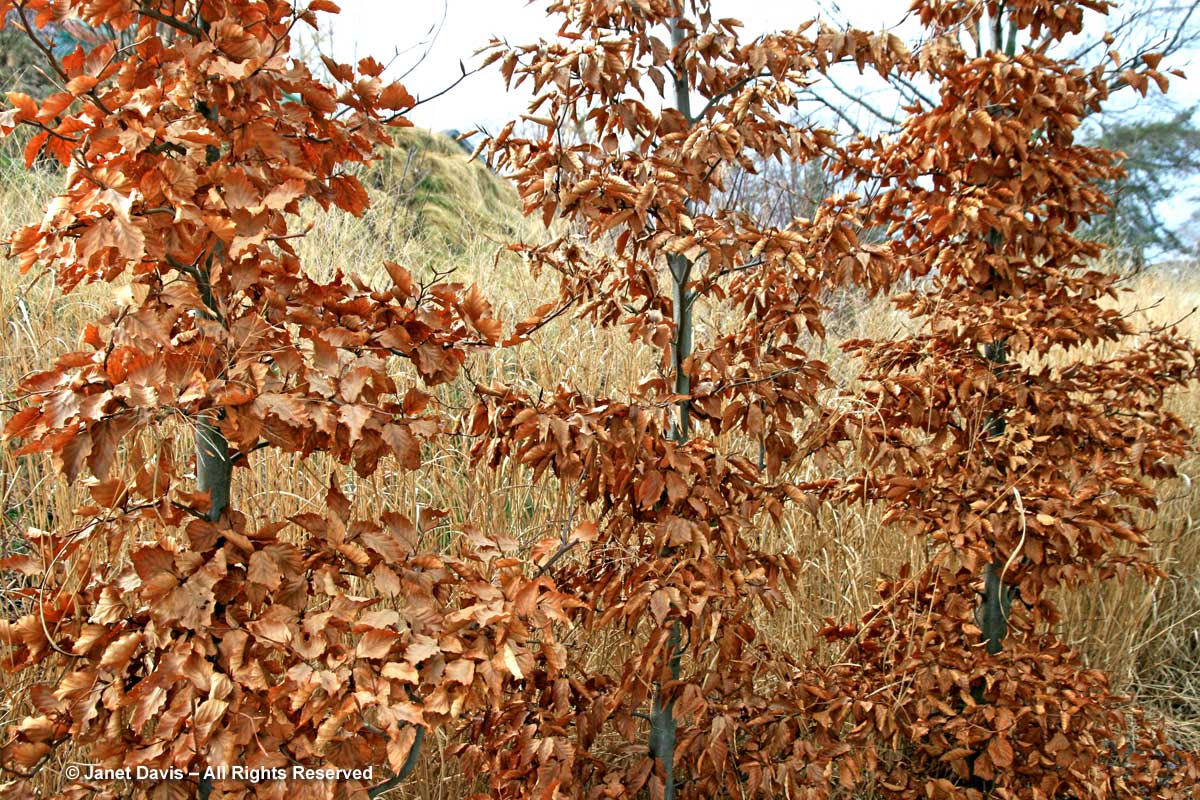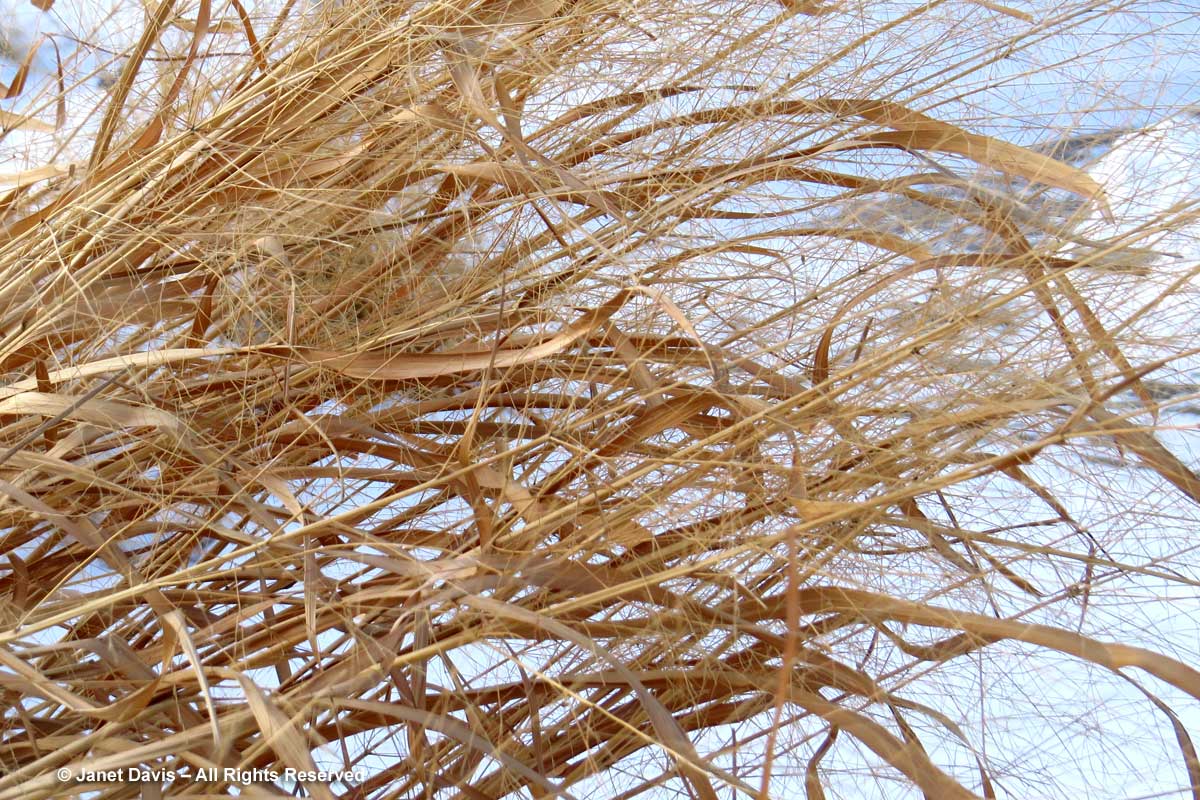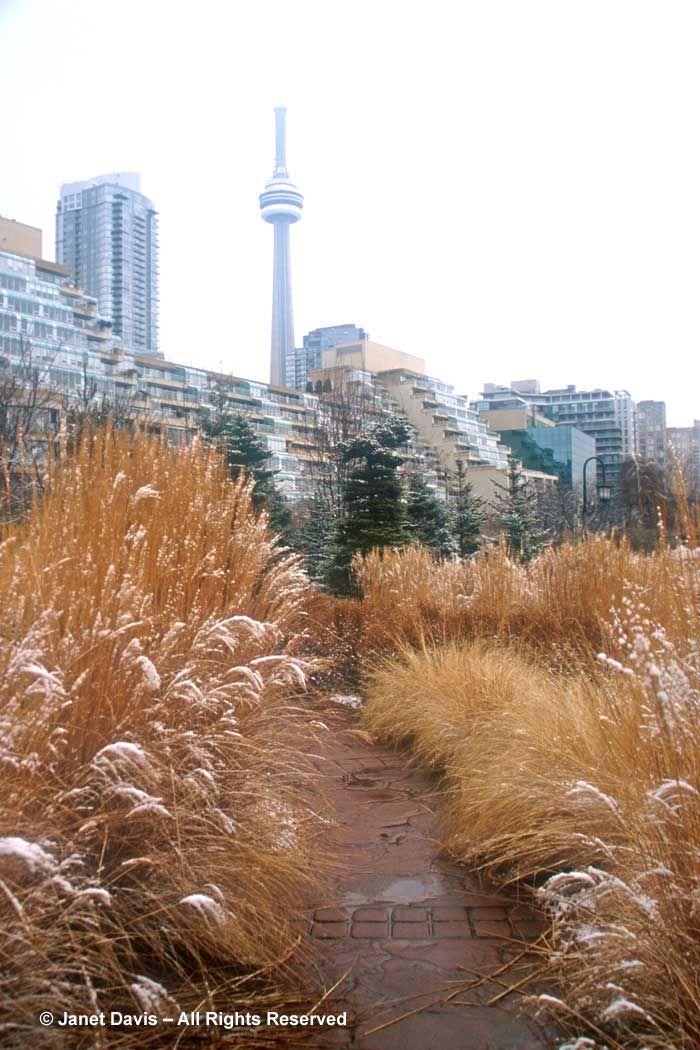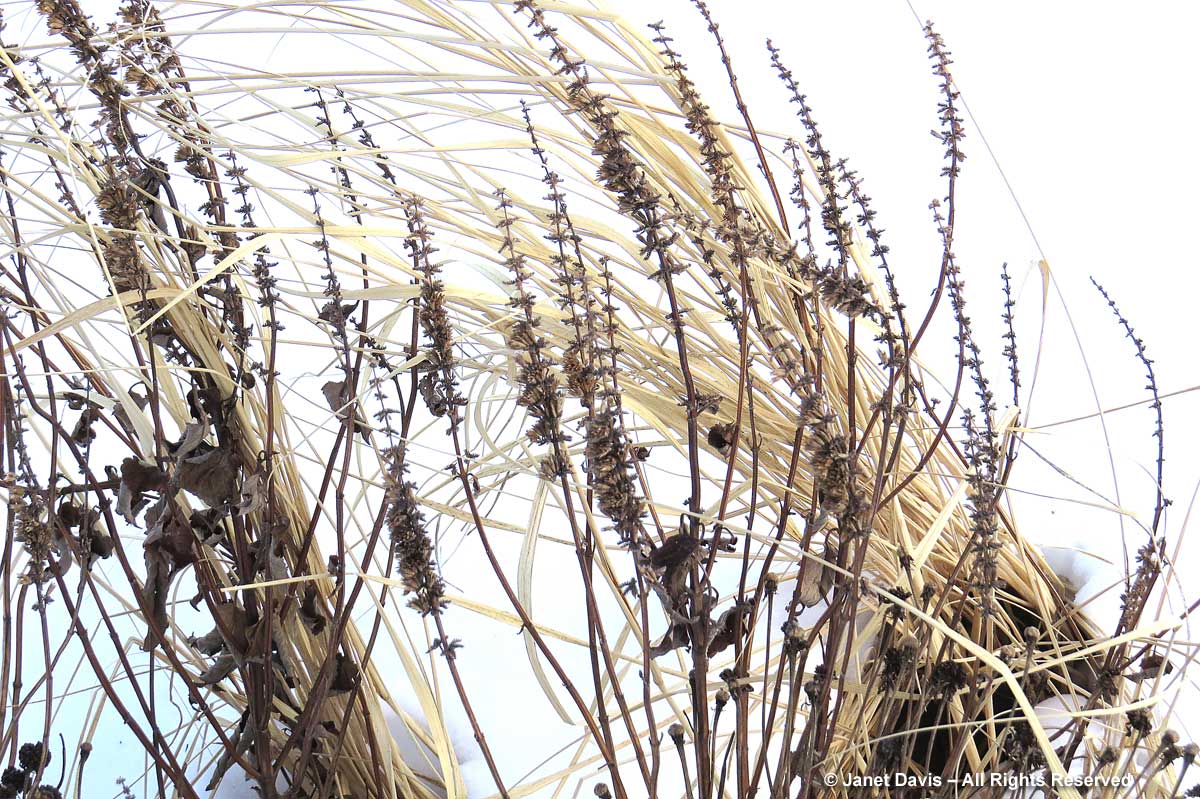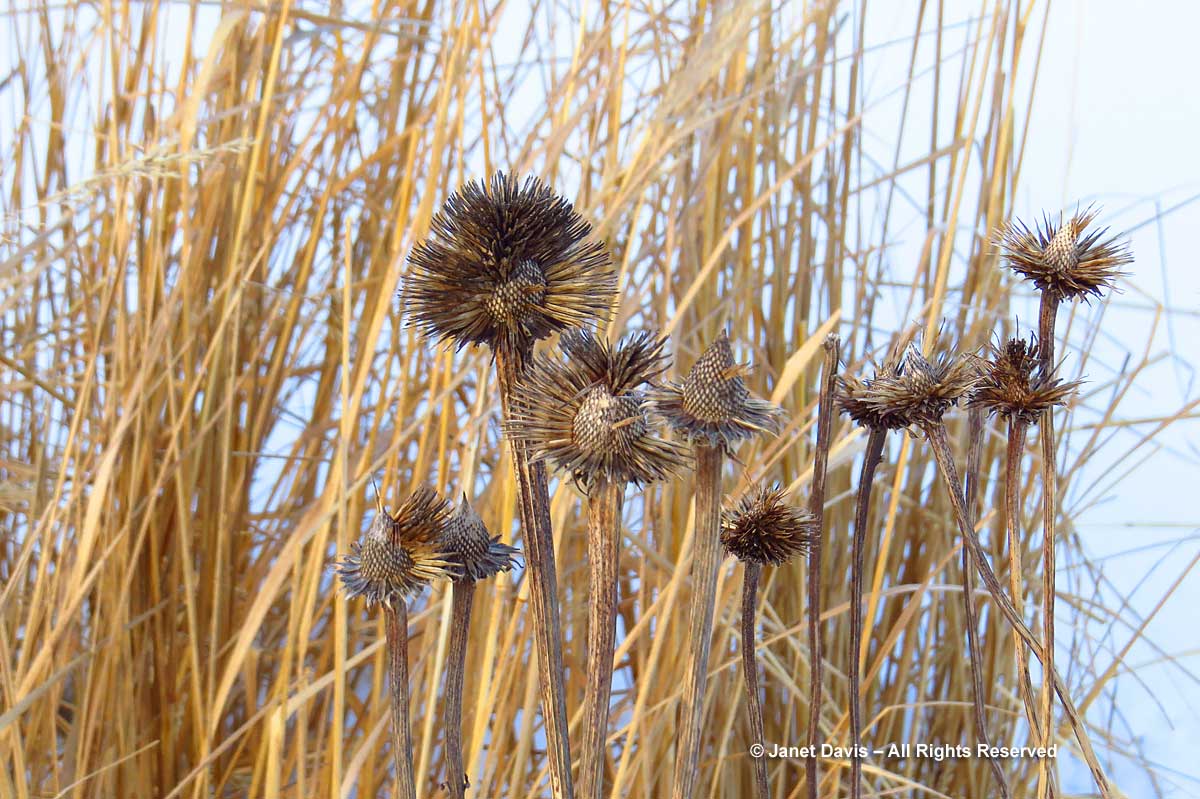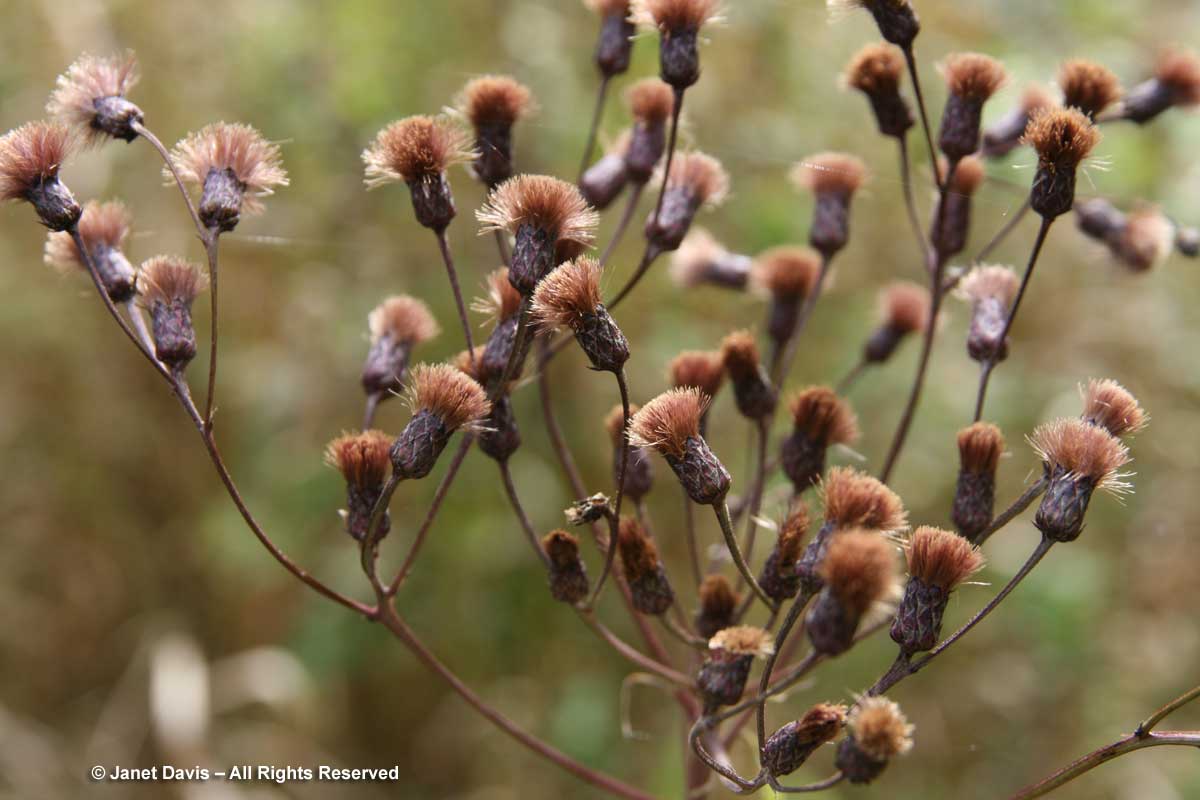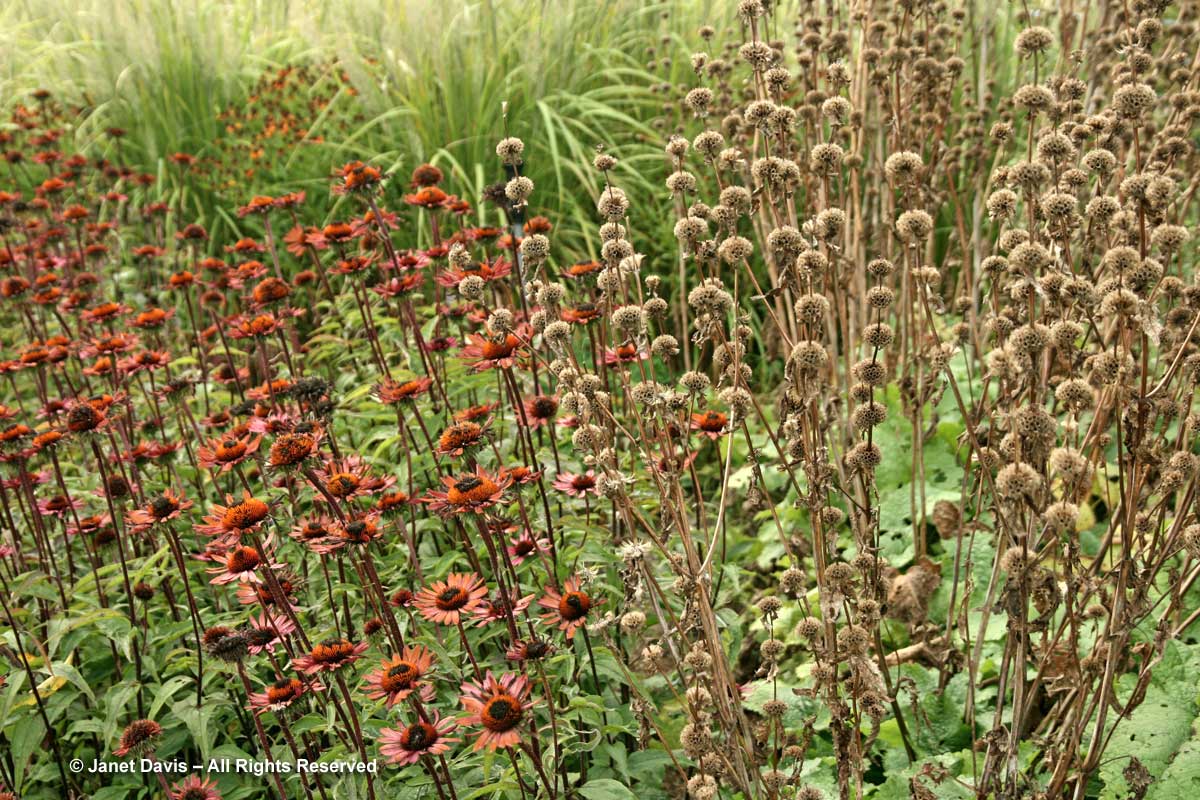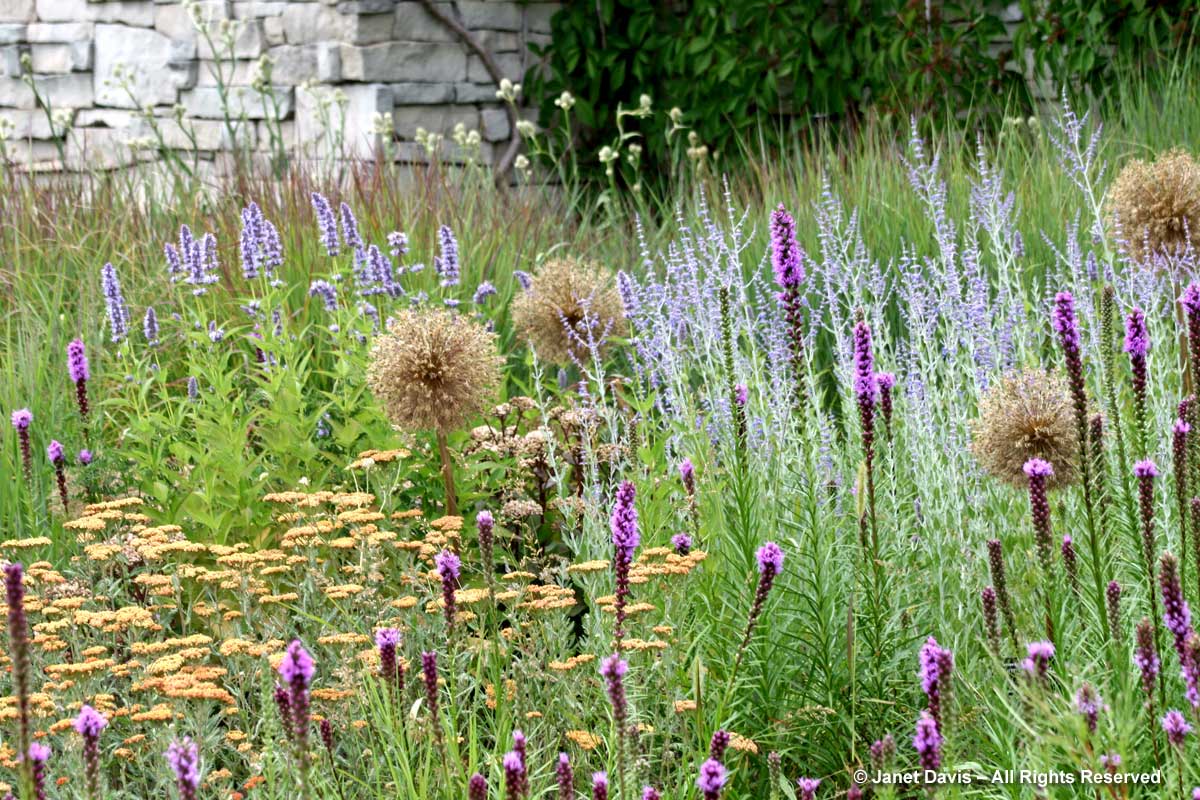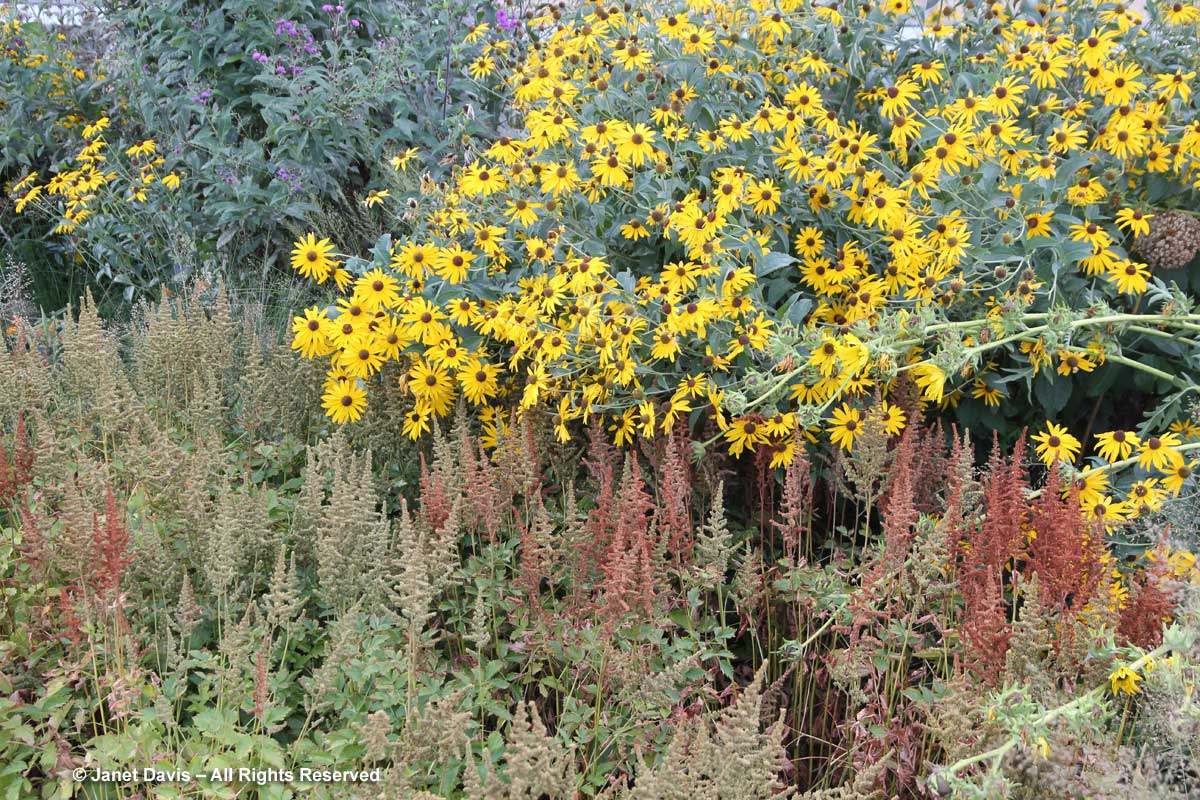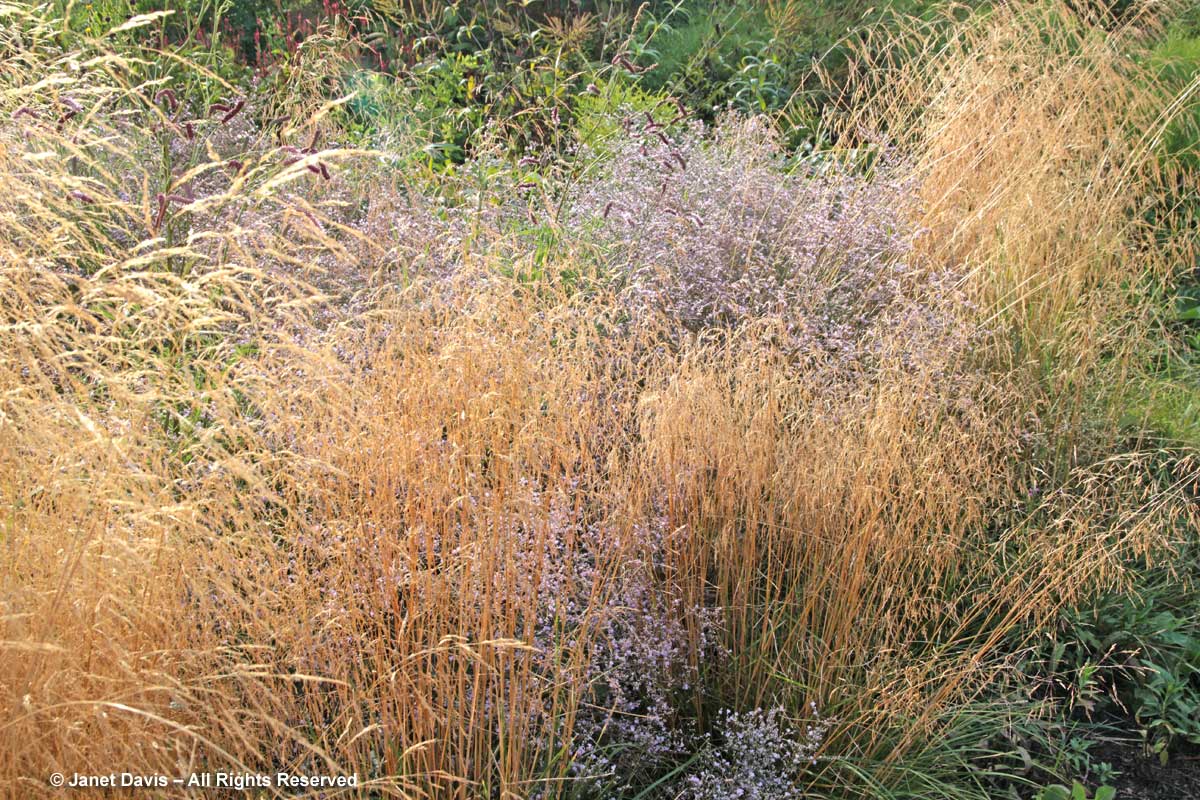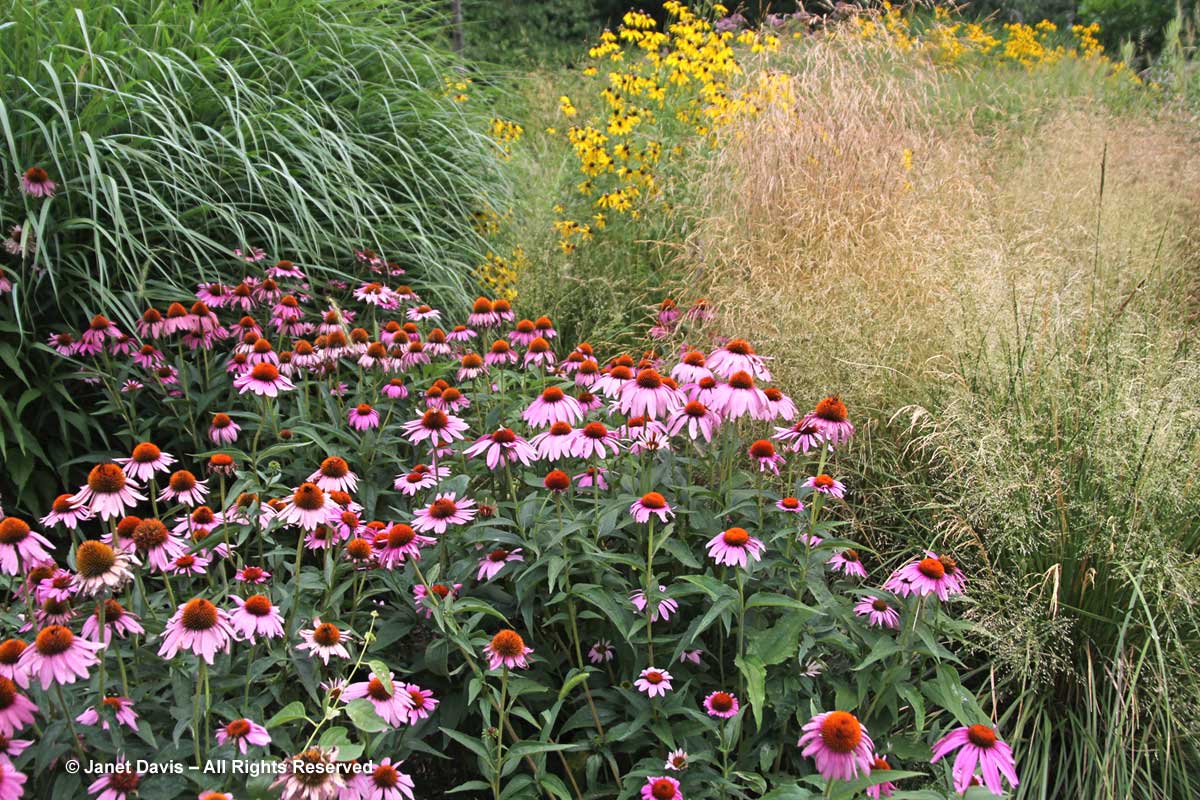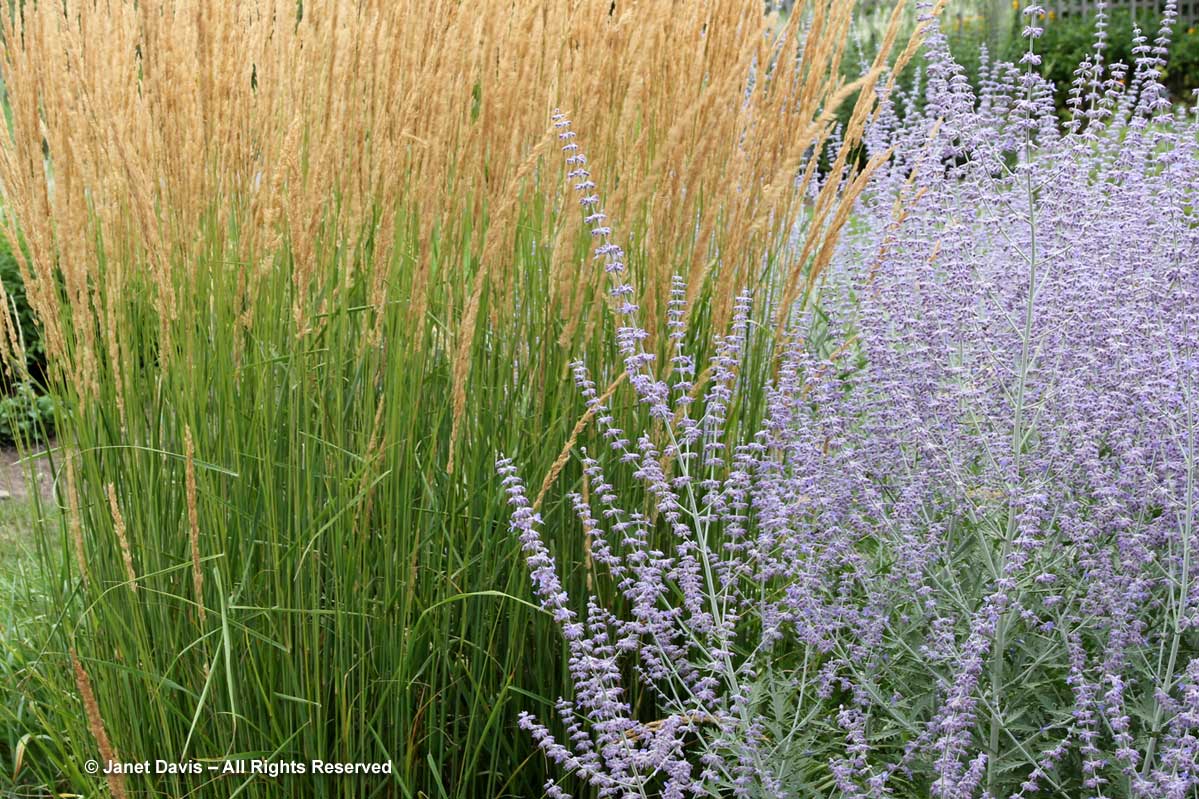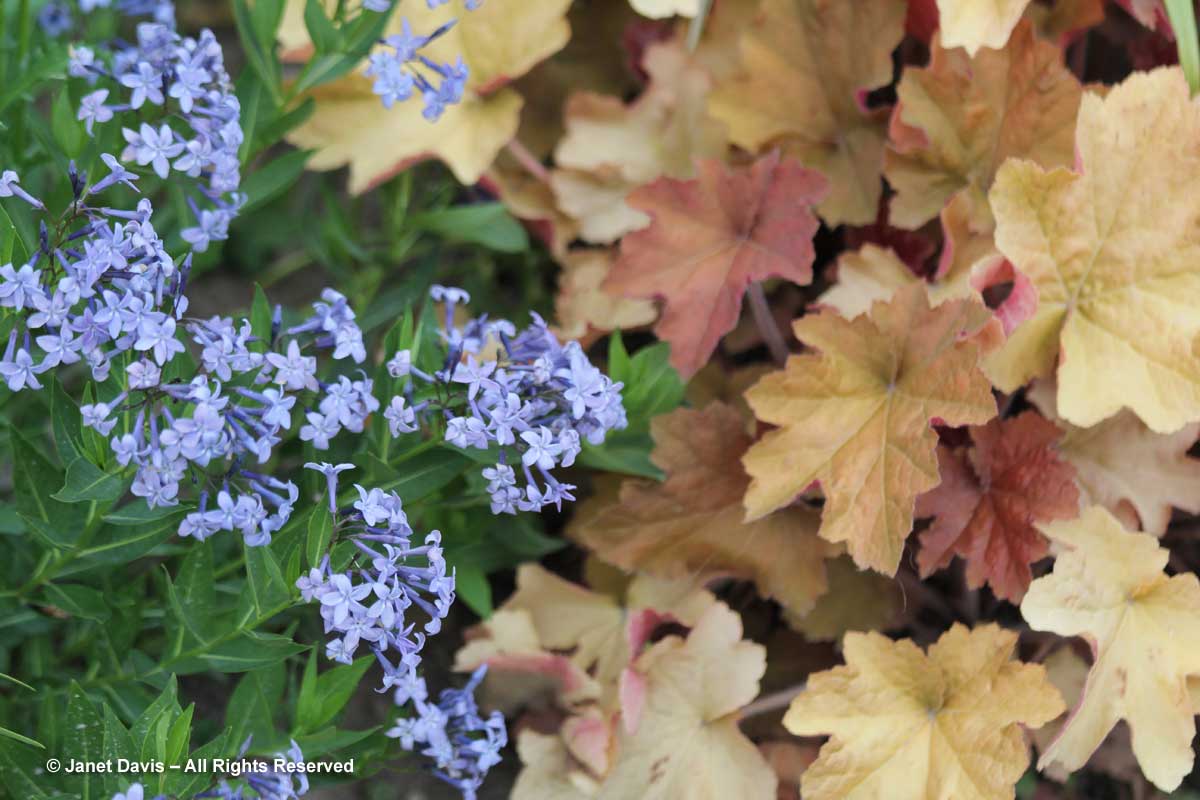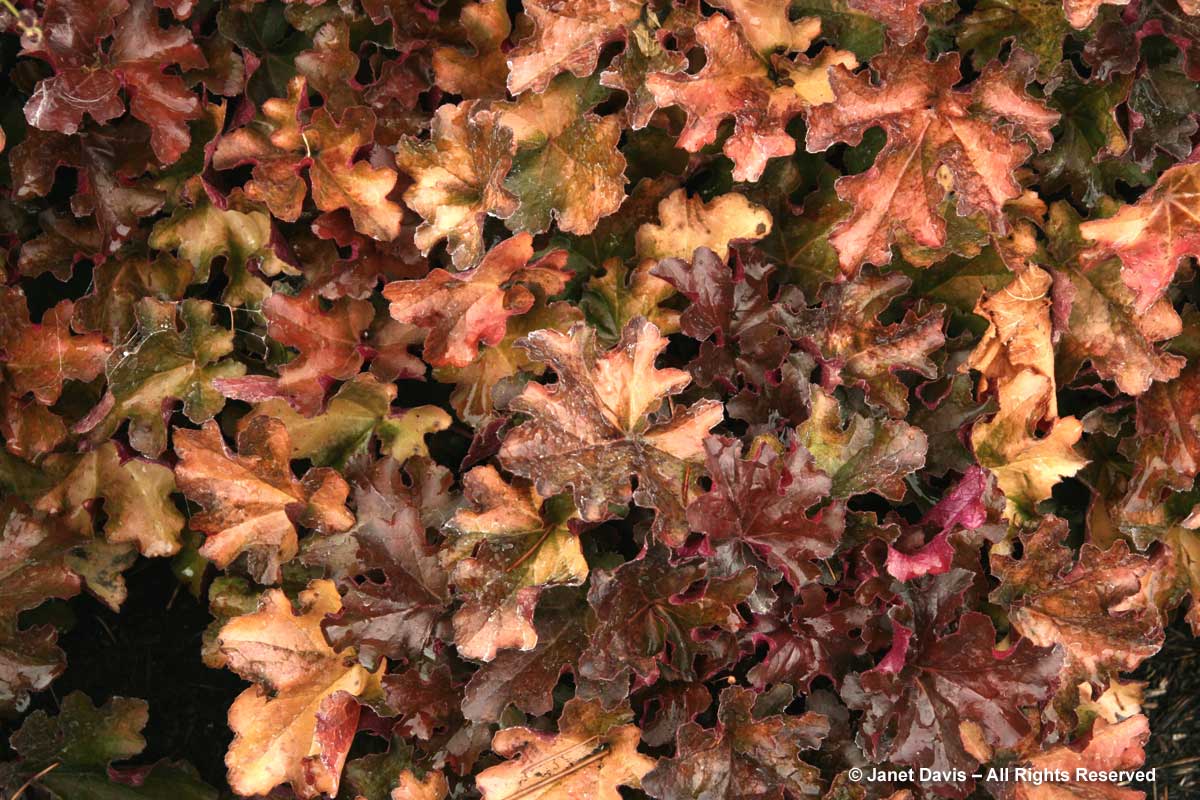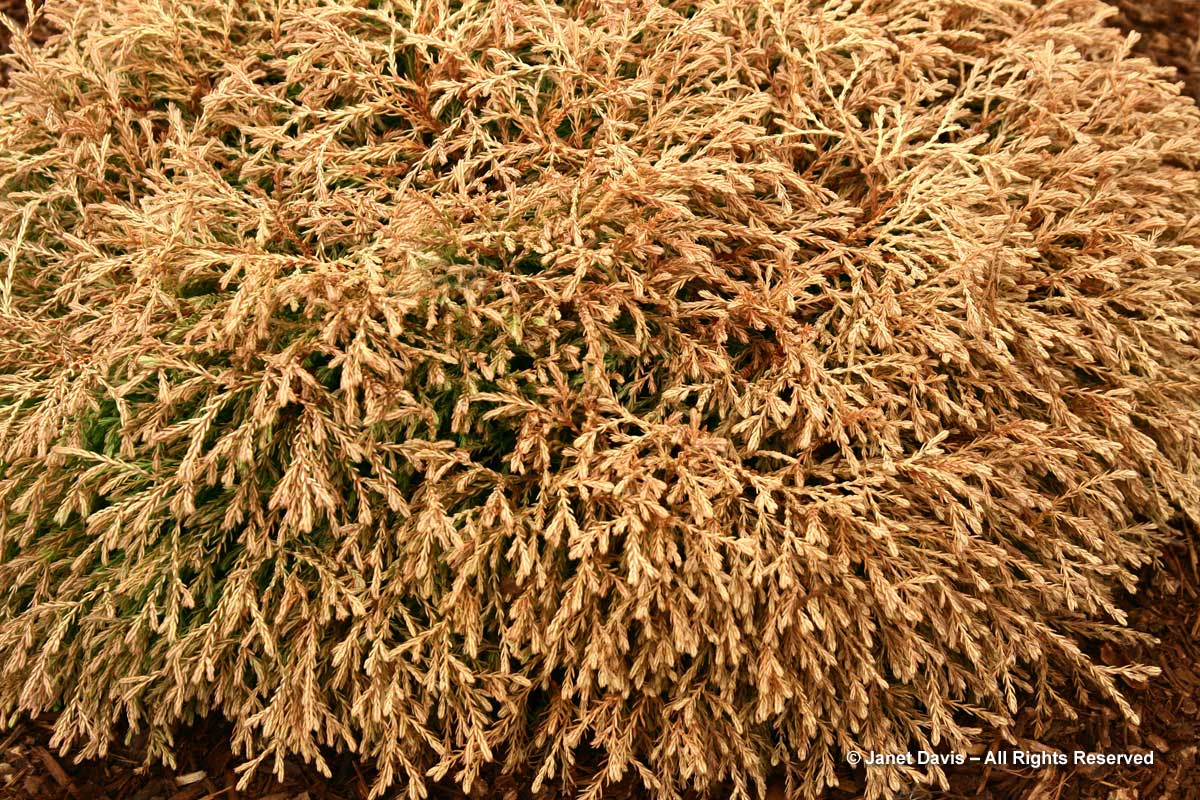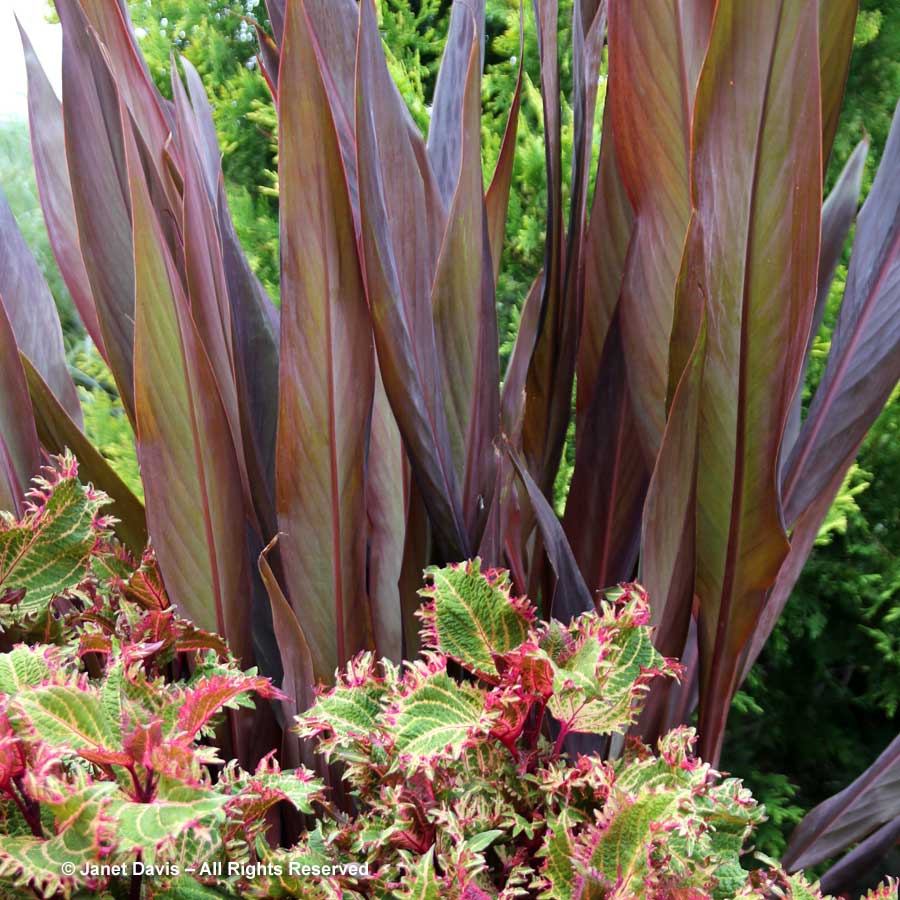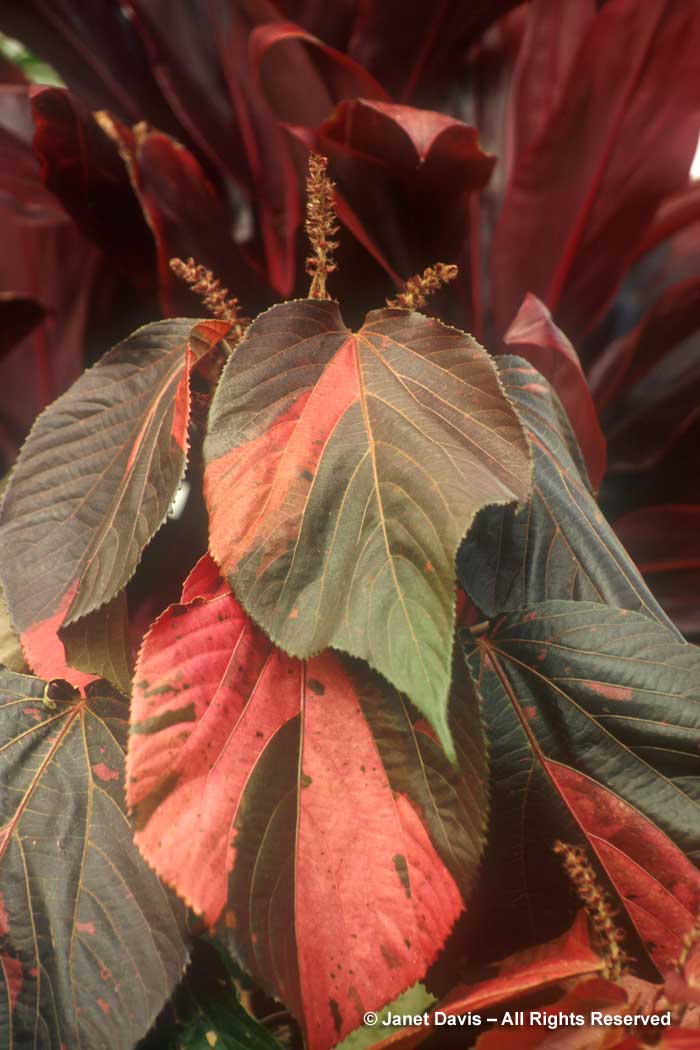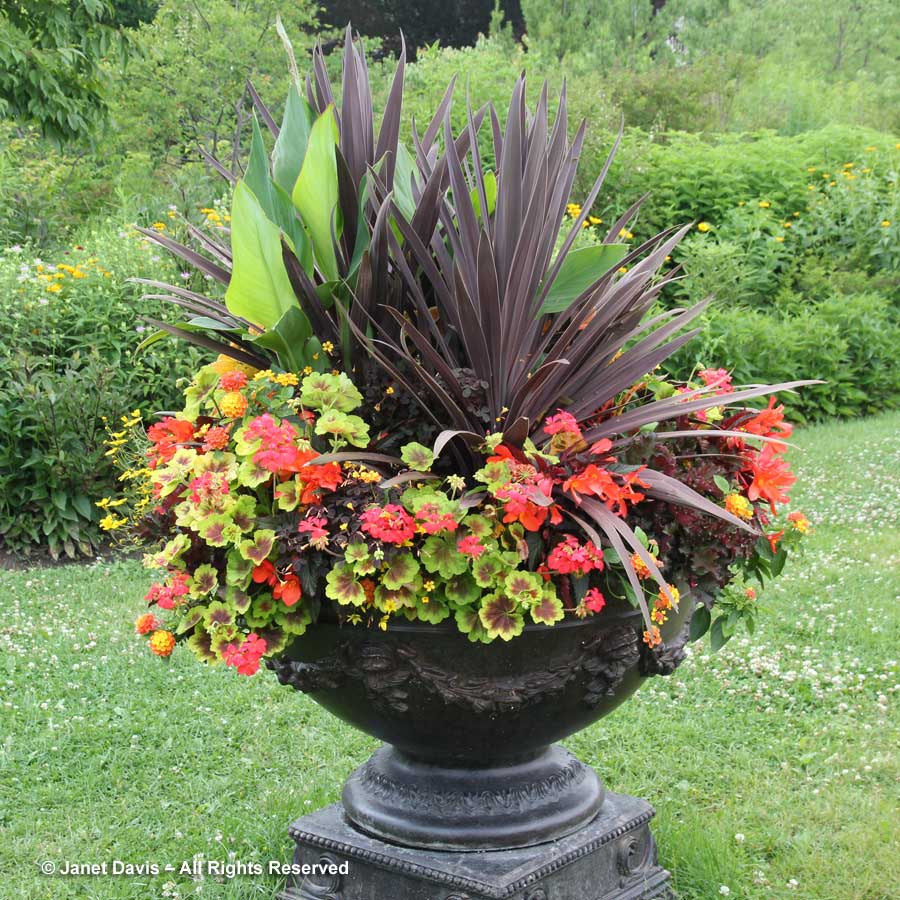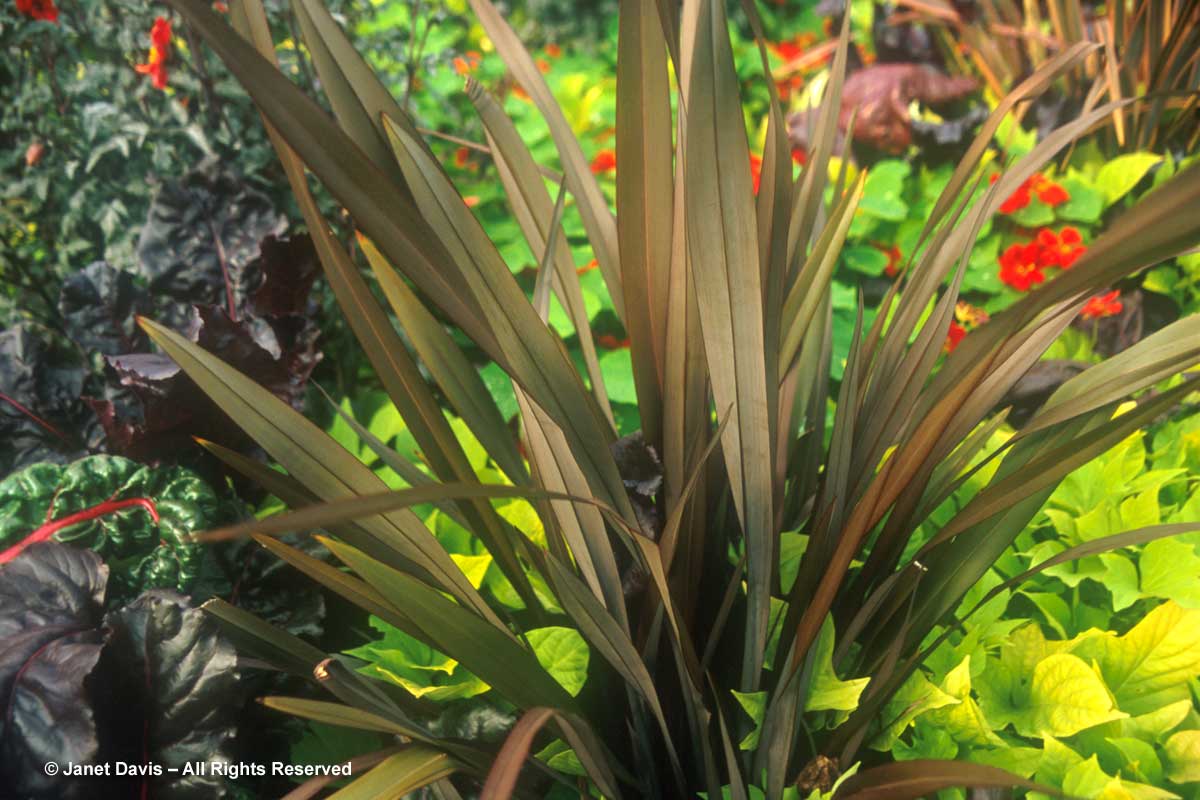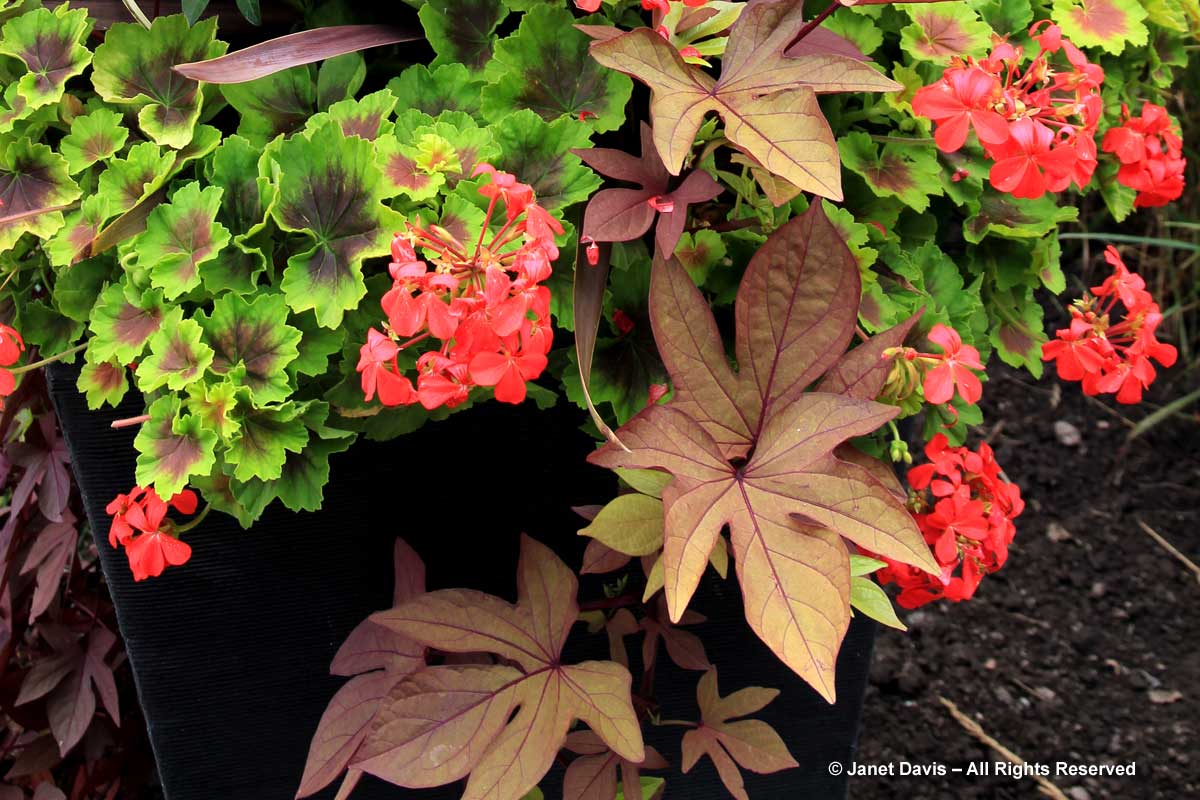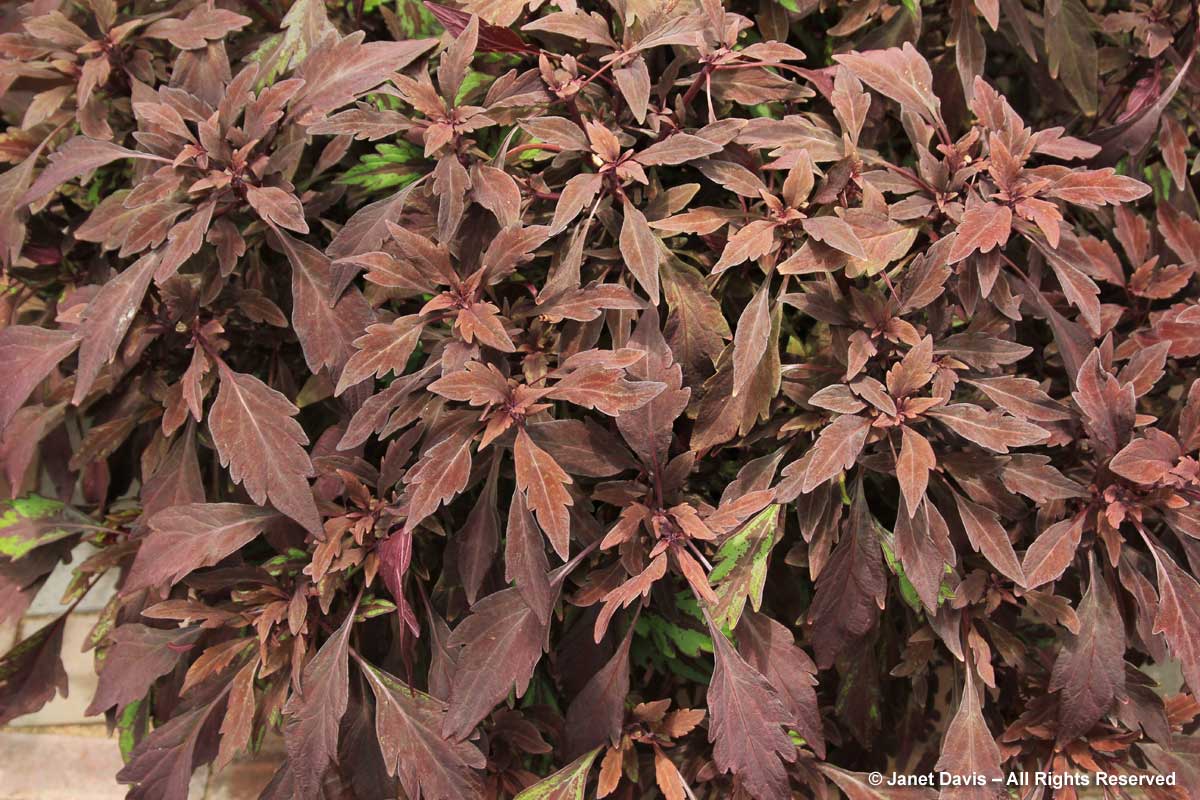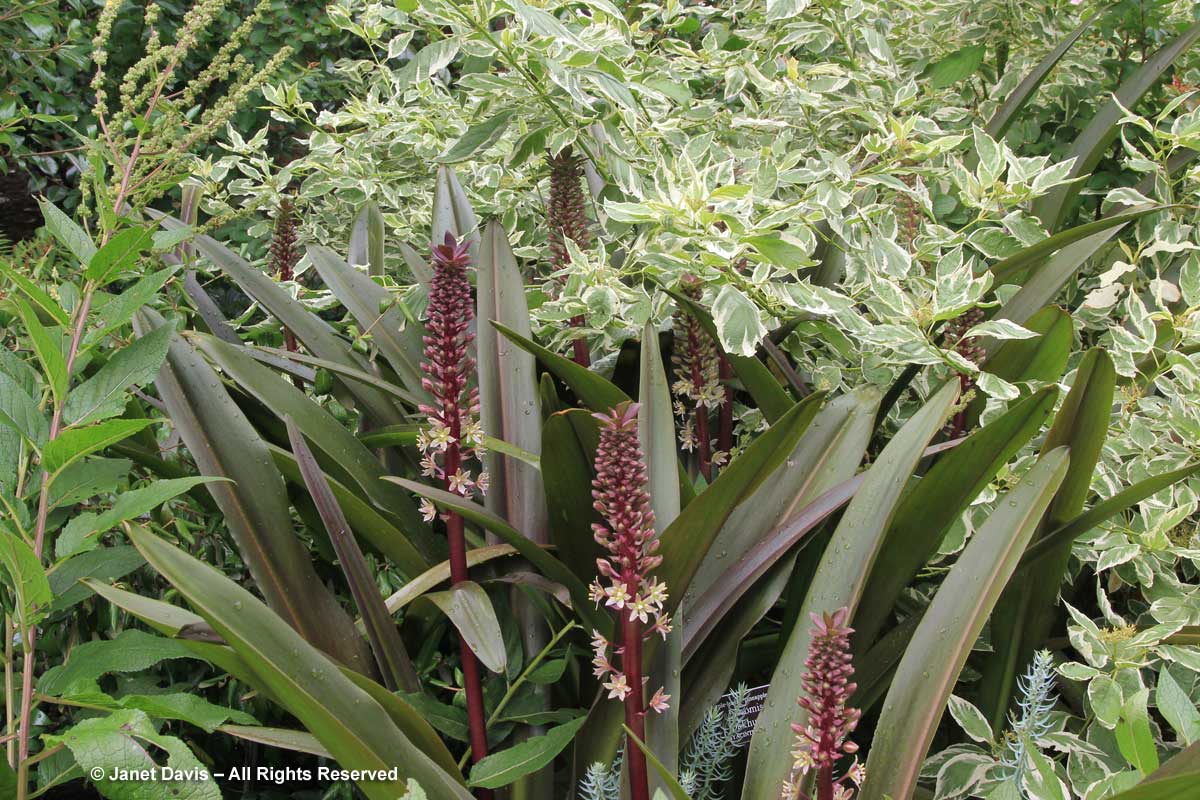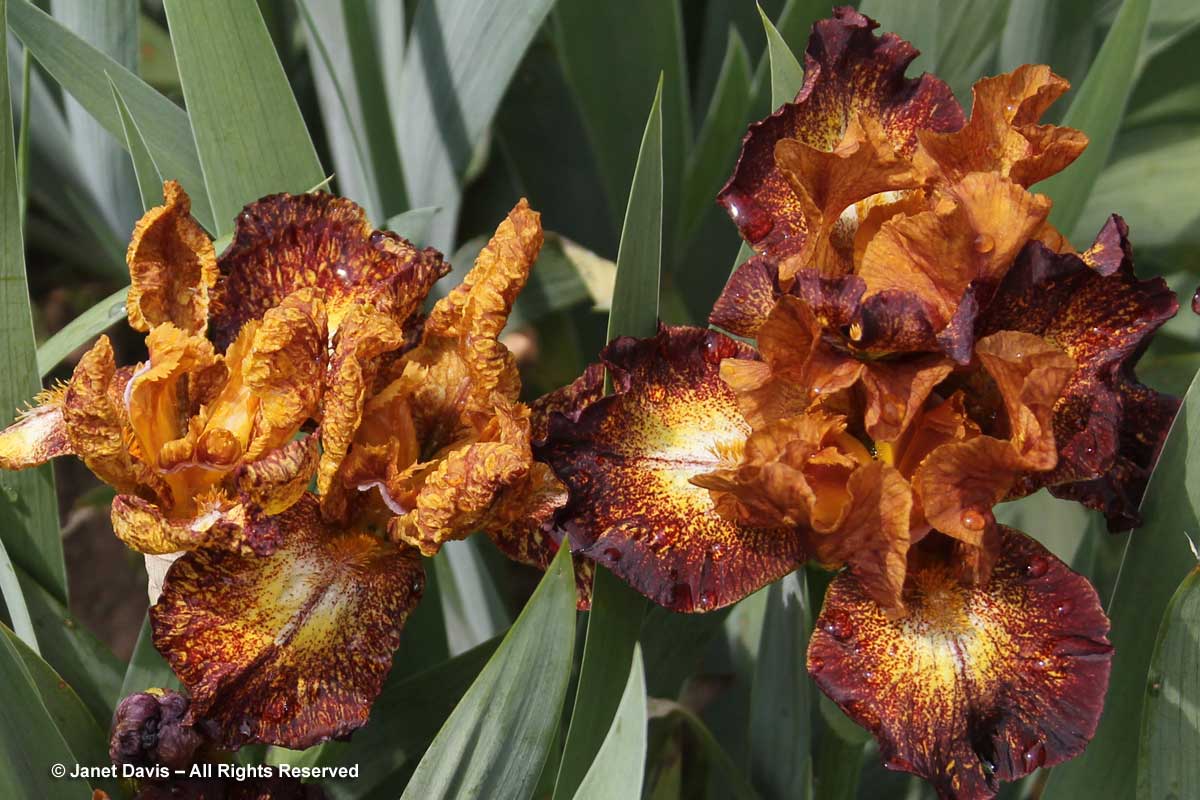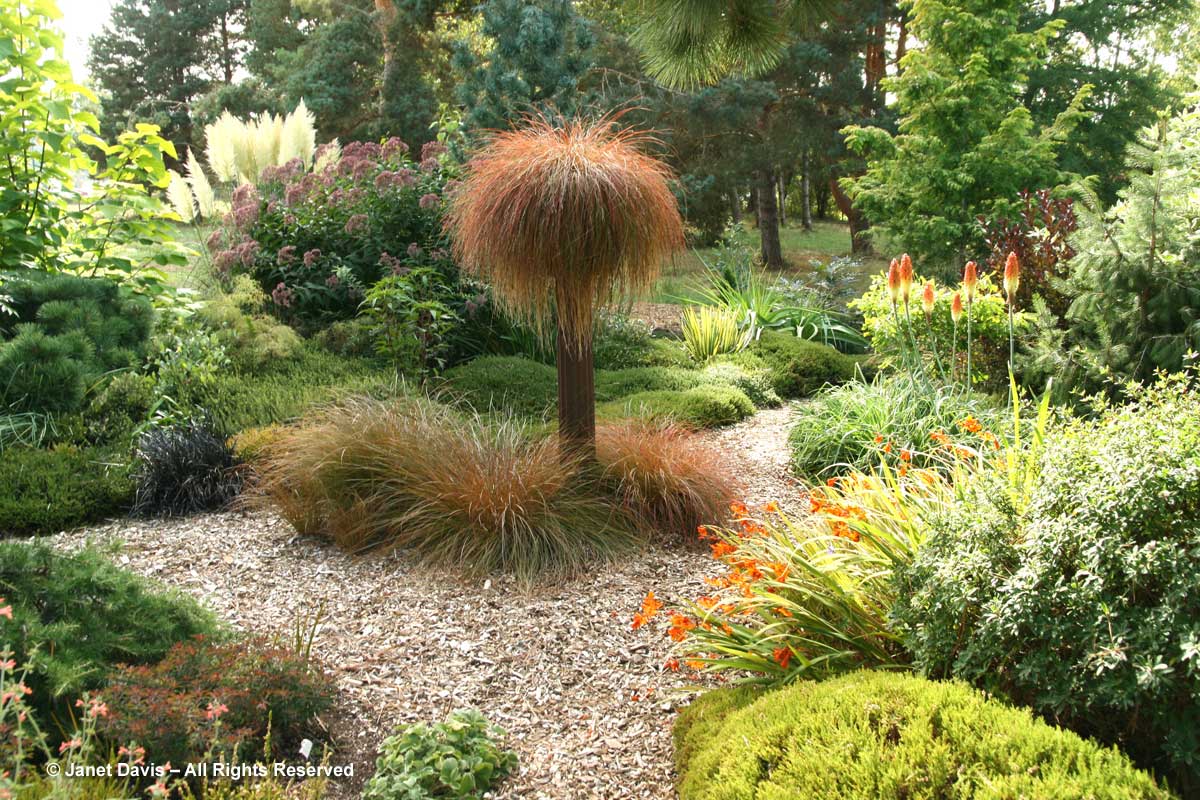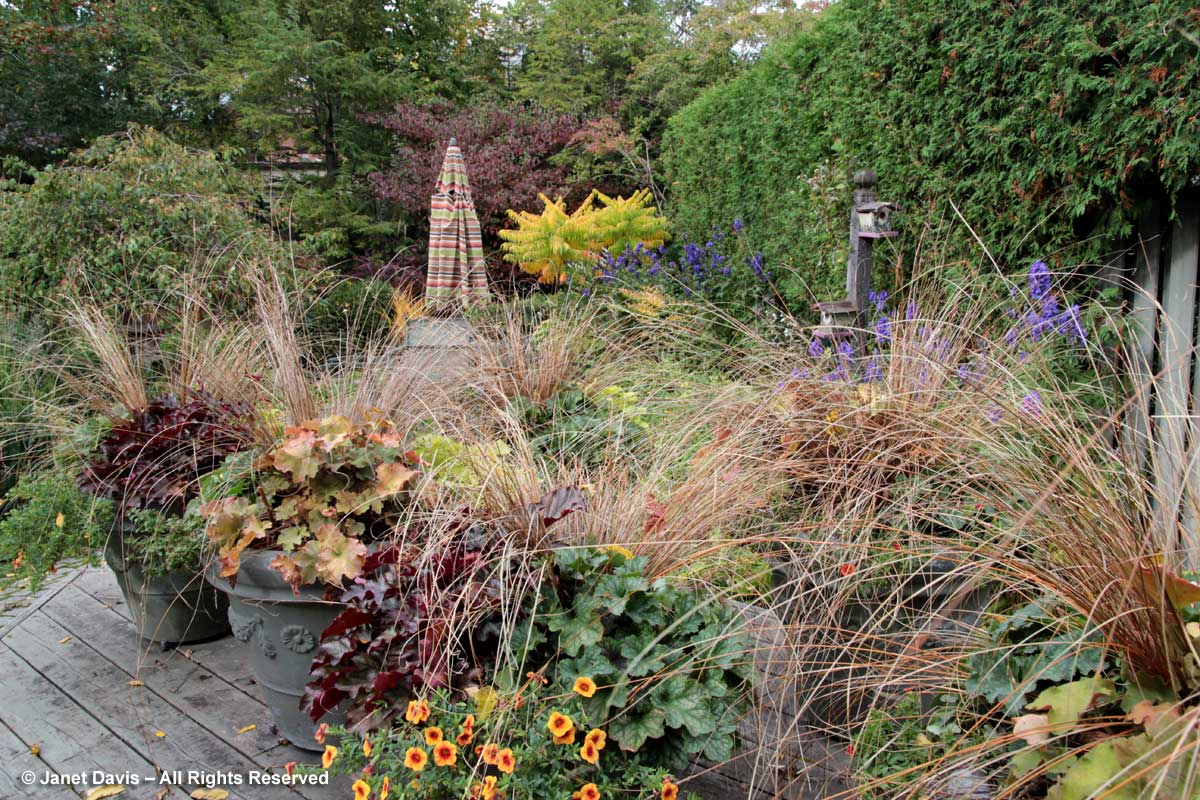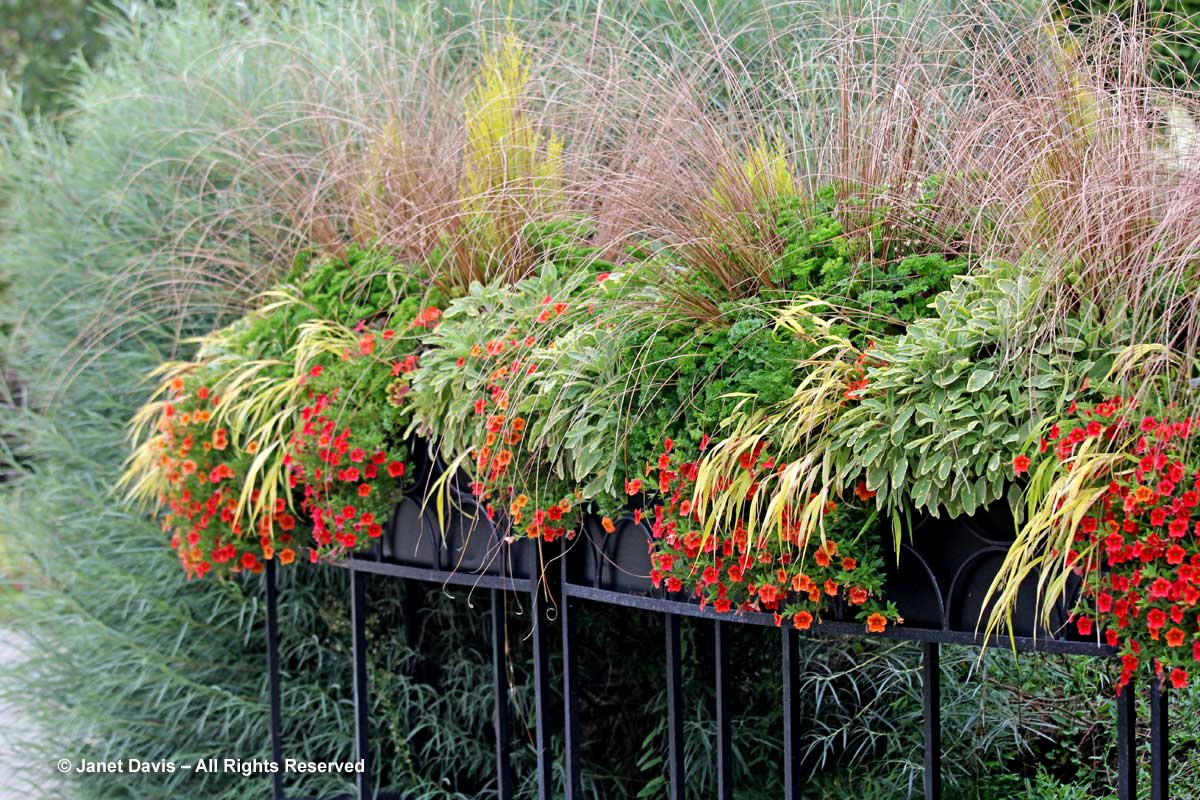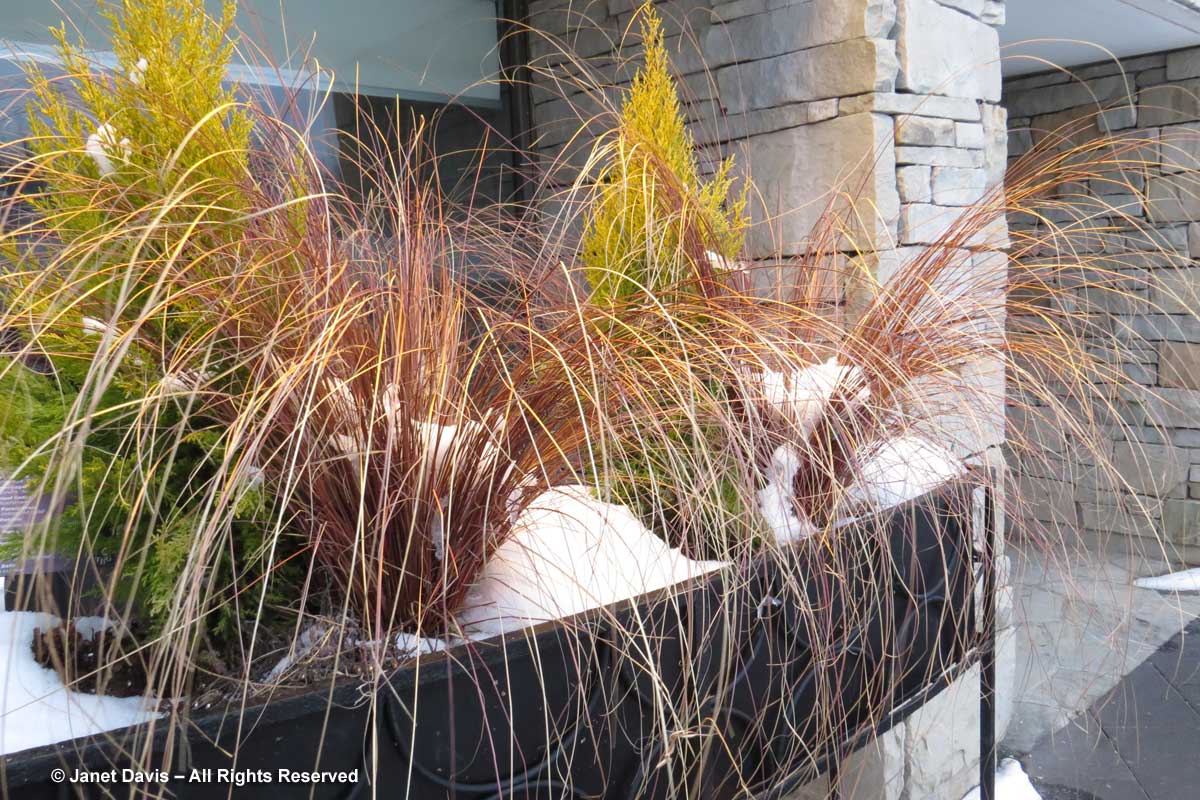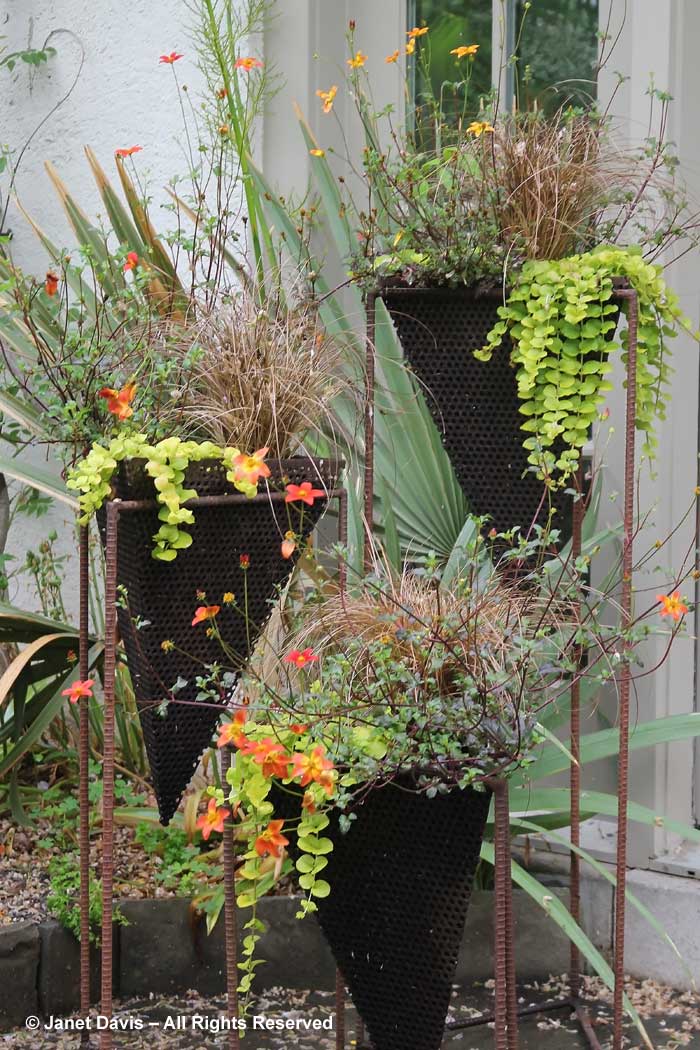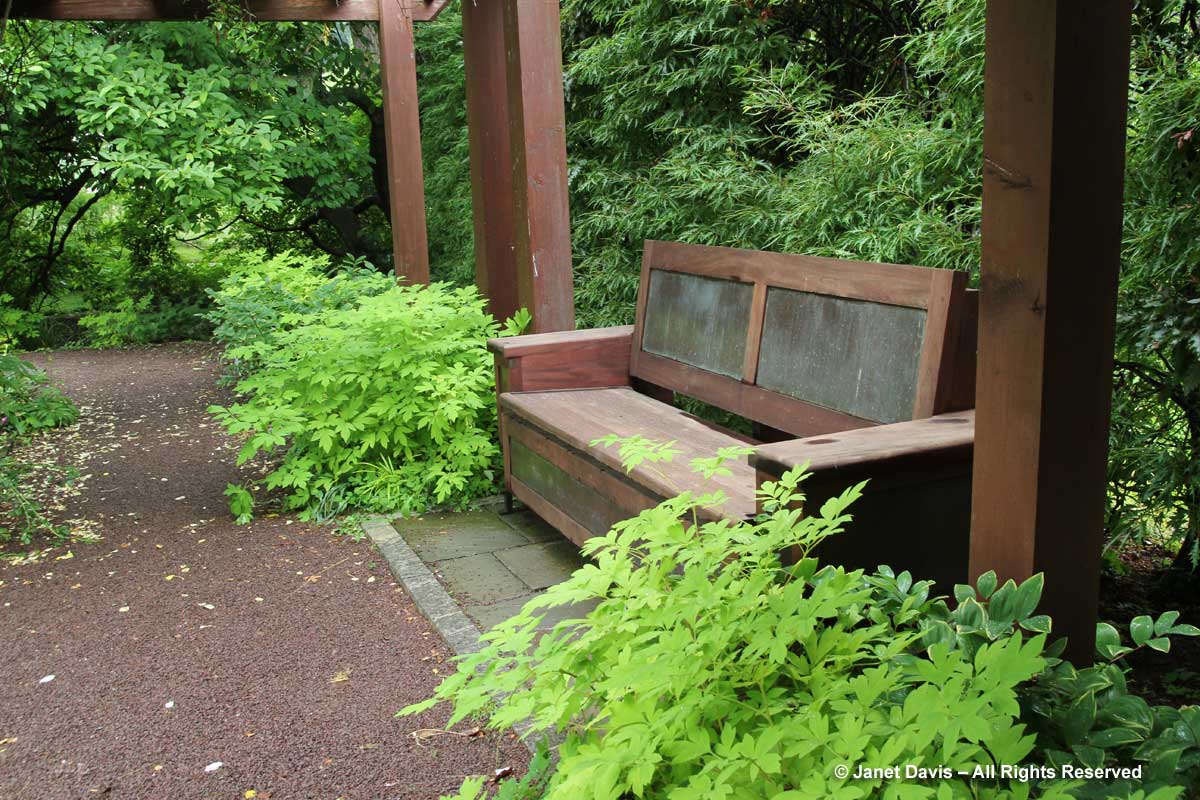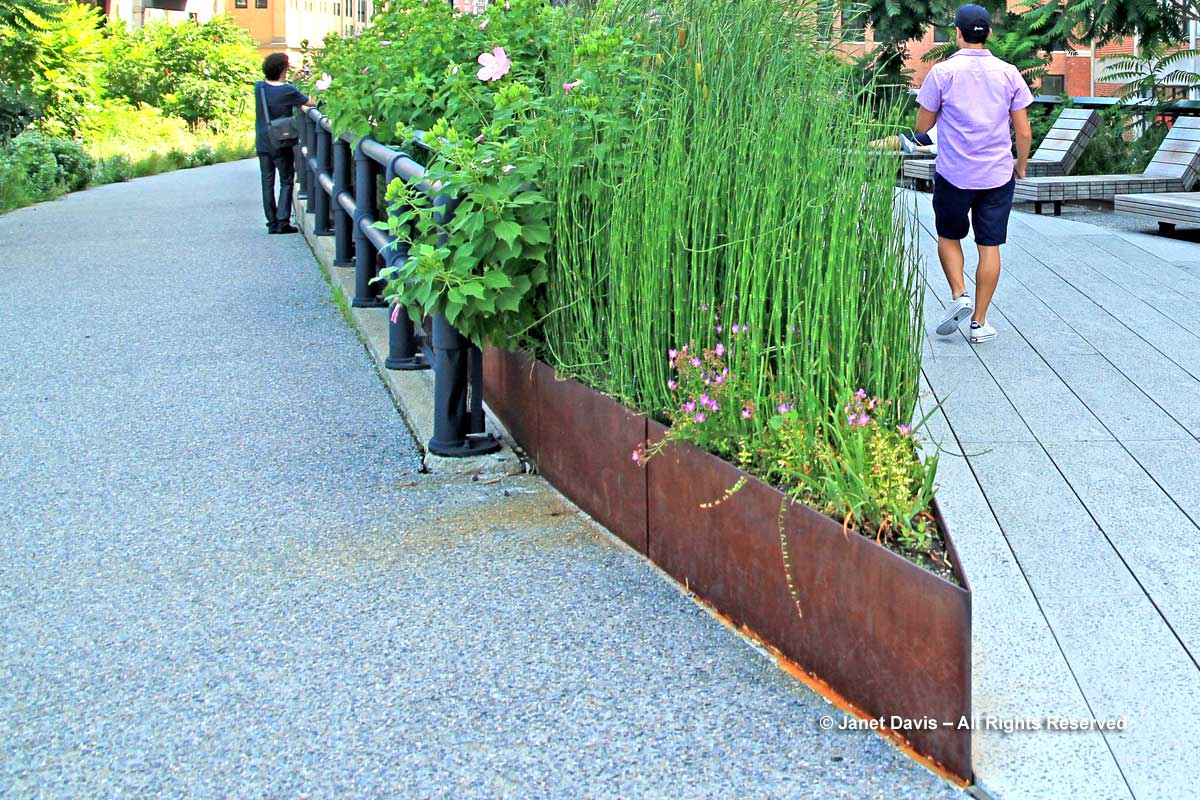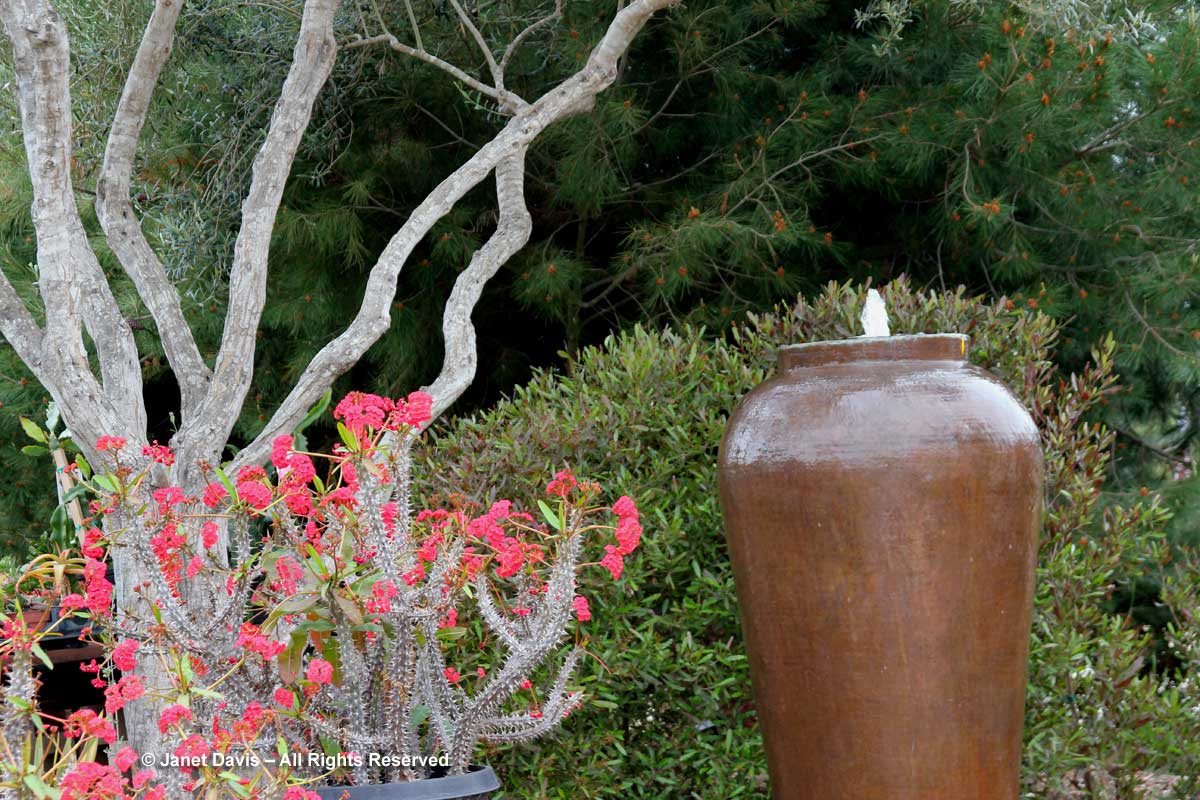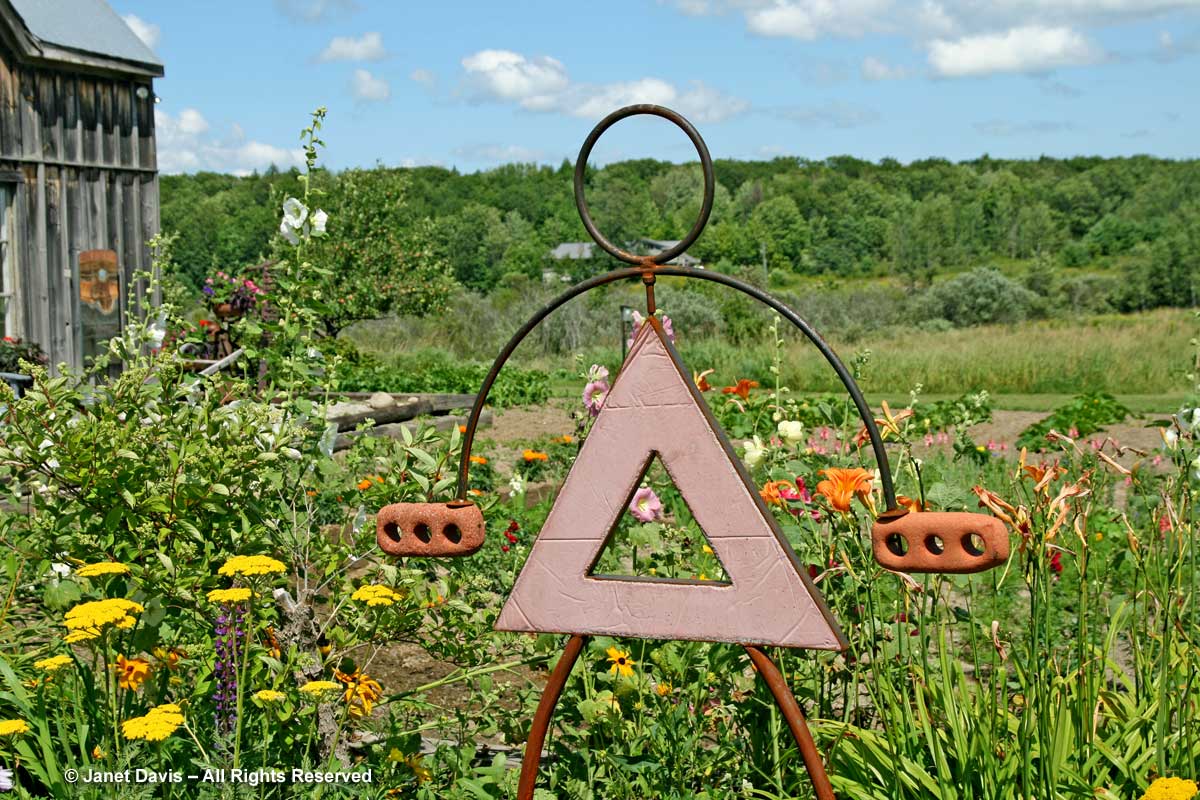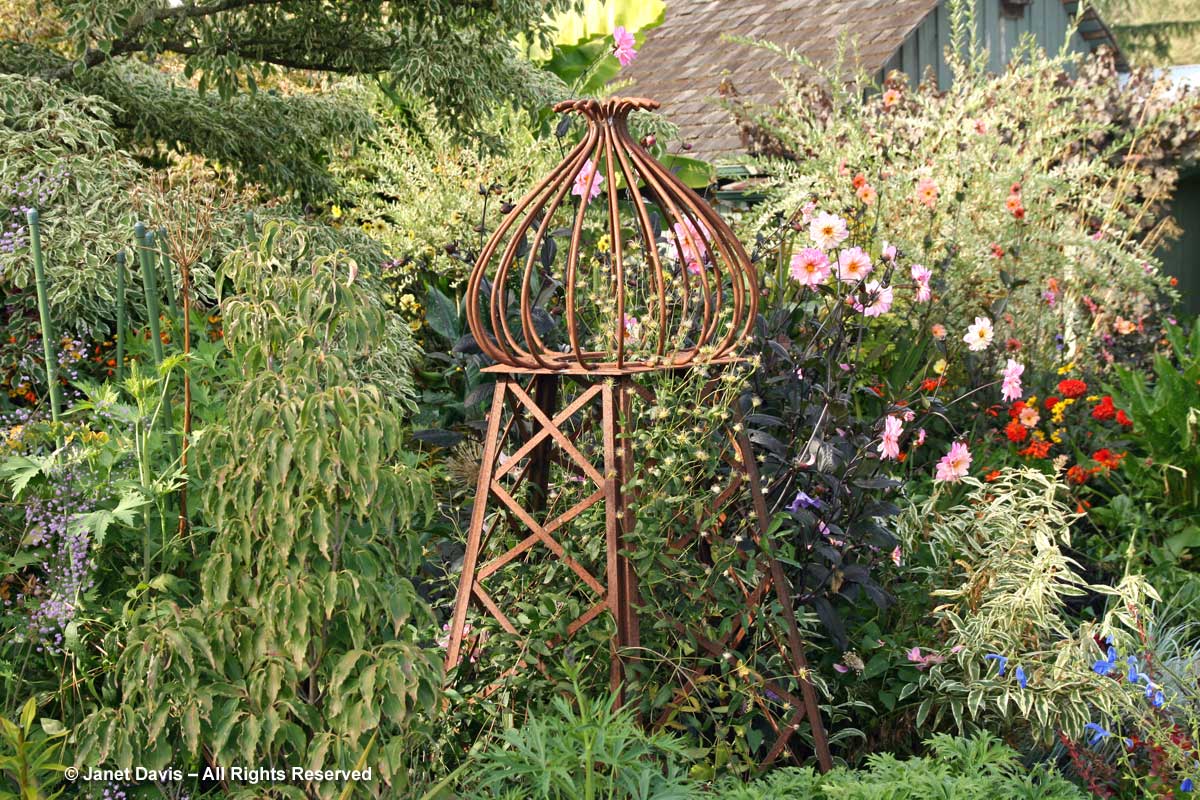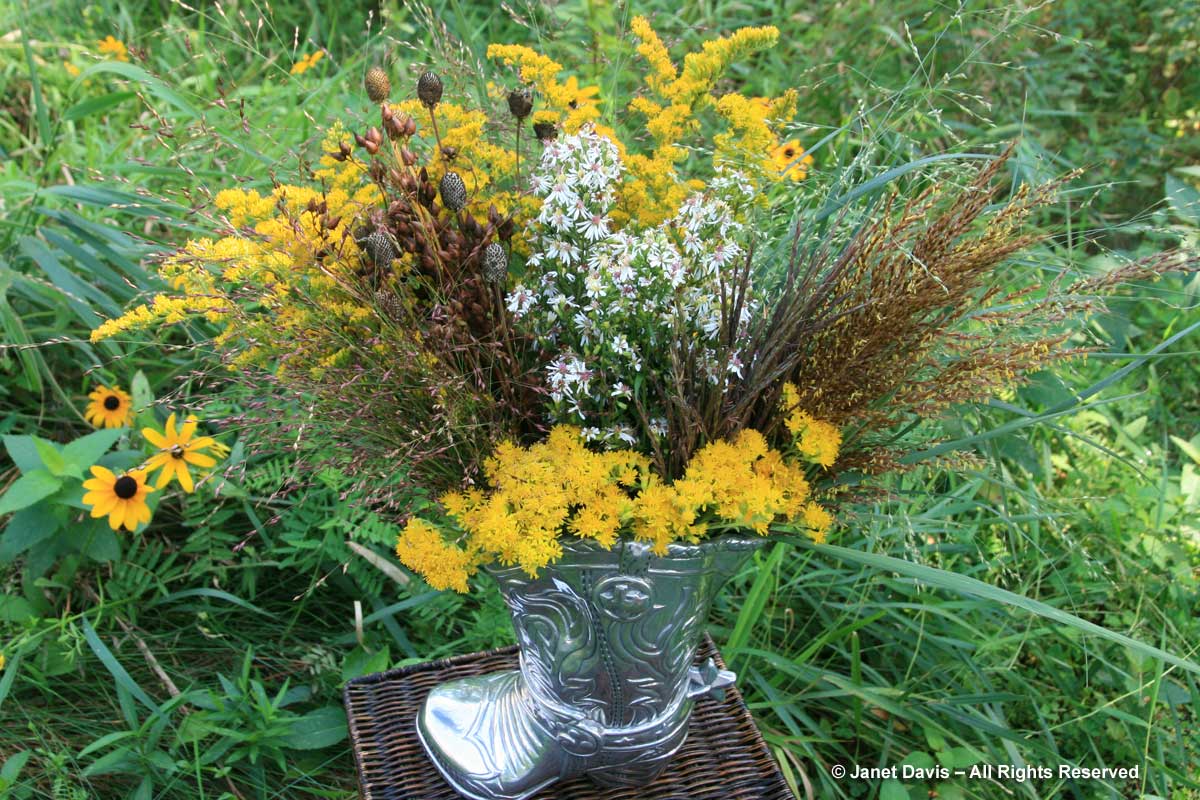On my recent Garden Bloggers Fling in Austin, Texas, we saw a variety of private gardens ranging from tiny, crammed-with-blossoms cottage gardens surrounding modest bungalows to expansive gardens framing large, modern homes. One that impressed me for its seamless architectural integration of house and landscape was Mirador. Both the house (designed by Jim Larue) and garden (by landscape architect Curt Arnette of Sitio Design) were finished in 2013 and are a beacon of fresh contemporary style in a neighbourhood of traditional, Mediterranean-style homes. It’s also the best example I’ve seen of using rusty Corten (COR-TEN®) weathering steel in all kinds of inventive ways in the garden. But if you read my blog on the Lady Bird Johnson Wildflower Center which we’d visited earlier that morning, you’ll know that a lot (3 inches!) of rain had fallen by the time we trooped down the driveway to Mirador in our dripping ponchos. My first view was of a soaked wildflower meadow spangled with blanket flower (Gaillardia pulchella) arrayed in front of massive Corten planters curved against the edge of the property and filled with agaves and yuccas.
As the rain subsided, the homeowner was able to put away her umbrella and chat with us. Though she grew up on a Nebraska farm, she’s lived in Austin for 35 years and taught herself all about gardening here. In planning the new garden, she had a wish list, much of it inspired by her travels. “Curt and I worked really well together, so I would tell him things I wanted incorporated and he magically made it happen.” Given that the property is downhill from the next-door neighbour, one of the challenges had been poor drainage in heavy rains, thus a deteriorating rock retaining wall built by previous owners of the property……
…… was replaced by tiered, curved Corten steel planters filled with drought-tolerant succulents. This was the view from the end of the planters closest to the house.
Look at those knife-edge steel walls. Corten, of course, is not “just” steel, but created with specific alloys that create the weathered look, while simultaneously slowing the weathering. Historically, the trademark for COR-TEN® steel was granted to the United States Steel Corporation in 1933, but it is now made by many companies. Note all the gravel here for drainage, and the Texas native silver ponyfoot (Dichondra argentea) making a great groundcover under the agaves and beaked yuccas (Y. rostrata).
To the left of the sloping driveway was a stately, little grove of bald cypress (Taxodium distichum), a Texas native. The meadow-like turf here and throughout the property is native Habiturf lawn (buffalo grass-blue grama-curly mesquite), developed at Lady Bird Johnson Wildflower Center.
Further down the driveway, a long limestone planter filled with statuesque century plants (Agave americana) lined the wall of the garage. In front is a geometric planting of muhly grass just emerging in spring from last year’s hummocks.
I’m sure those agaves would have liked a little less moisture than the monsoon that had befallen them that morning.
Fortunately, the rain slowed as we got our bearings, for this was a garden to be explored carefully – even though it felt a little wrong to wander in dark clouds and drizzle through a succulent-rich garden clearly designed for sunshine. The view below is past a guest house/studio on the left with an enclosed courtyard garden, garage on the right, towards the house with all its complex and interesting roof angles.
That Corten is so perfect here, with the pale Texas limestone and stucco palette of the house and other buildings. The tree is Texas cedar elm (Ulmus crassifolia).
Below is an airy gate leading into the courtyard garden.
The gardens are an interesting mix of natural and formal, like this little boxwood allée. I loved the steel wall doubling as a planter…..
…… with the wood-and-stainless-steel bench in front. That long flower spike comes from the Texas native giant false yucca (Hesperaloe funifera).
Before we go into the courtyard, let’s walk up to the front door, past this fabulous whale’s tongue agave (A. ovatifolia) and the casacading Palmer’s sedum (S. palmeri), its little yellow flowers nodding their soaked heads after the rain.
Look at those lovely slabs of cream limestone. Notice that we’re still going downhill, via that small step (and it’s still raining a little). Later, we’ll see that the back of the house descends even further.
Now let’s step into the courtyard and head down the Corten-edged gravel stairs. The plants here are firecracker plants (Russellia equisetiformis), with tiny, tubular red flowers sure to attract the hummingbirds the homeowner wanted to invite into her garden.
Inside the courtyard garden, the Nebraska farm girl seems to have found the perfect marriage of abundant vegetable garden and French potager. “My garden is mostly for my family and me to enjoy: vegetable picking with grandkids, sharing organic veggies with my daughter,” she says.
In early May, the Swiss chard looked healthy, along with self-seeding larkspur and violas. And probably the prettiest tomato cages I’ve ever seen (more Corten!)…
There are roses in the potager, too. As the homeowner says: “I wanted to have some cutting flowers and vegetables mixed in with roses. I never thought I would enjoy roses, but have fallen in love with antique roses”. She specified many for their fragrance. “Stopping to smell the roses is really a good thing.” Though we missed the antique roses by about two weeks, there were still a few ‘Knock Out’ roses in bloom, below.
Looking in the other direction, the elegant, concrete water feature here reflects the sky (and I’m sure it brings lots of birds as well.) There’s phlomis and catmint here; the little multi-stemmed tree is Texas persimmon (Diospyros texana). Beside it is an architectural scrim of horsetails (Equisetum hyemale)…..
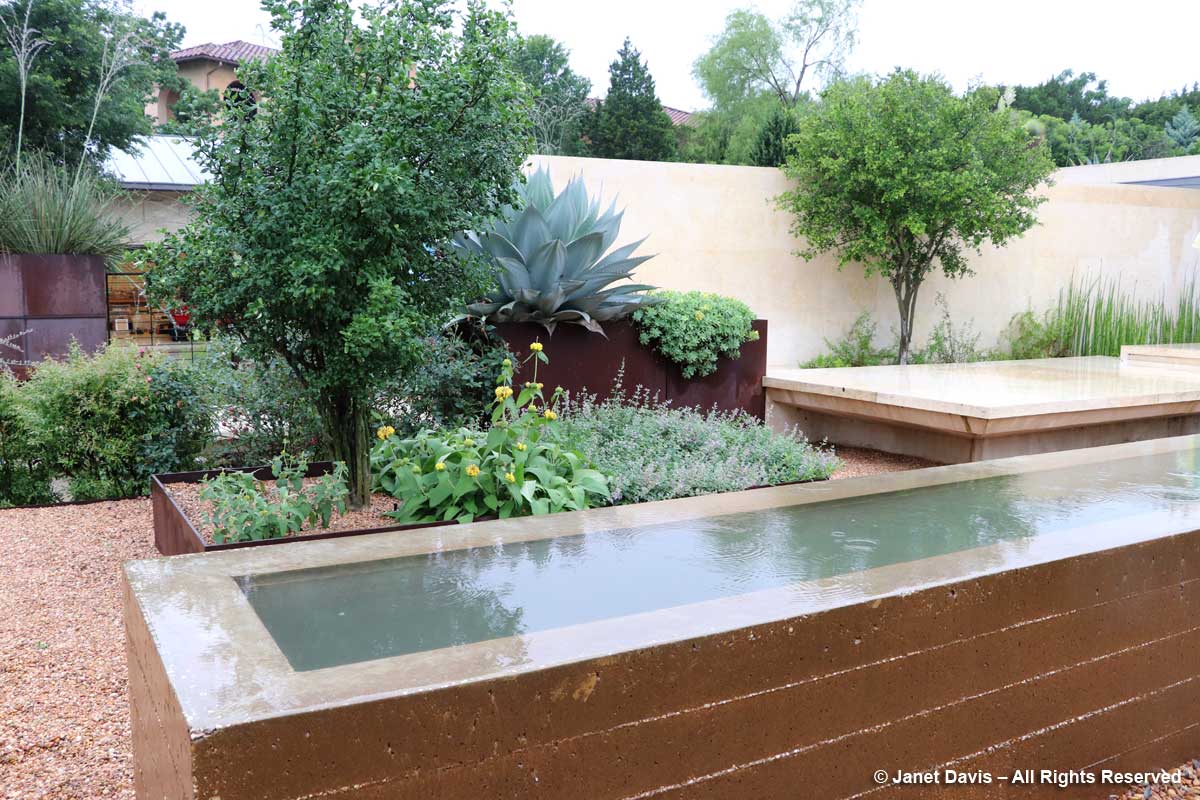
…. cleverly trapped in an enclosed space. (If you’ve grown horsetails, you’ll know why).
The courtyard garden has its own comfy chairs.
As I looked towards the back of the property, I caught a lovely, long rain chain doing exactly what it was meant to do, then directing the rain into appreciative bamboo below.
I hurried out of the potager area past the pineapple guava…..
….. and the pretty glass ornaments……
…..down behind the house to find the swimming pool – a welcome oasis in hot Austin summers – and an appropriate interpretation of an infinity edge…..
….. with its Corten walls.
Isn’t this sweet? Blackeyed susans from the garden.
The hot tub was nearby…..
….. and featured more beaked yuccas (Y. rostrata) against the rough-cut limestone of the house wall here.
The view from the hot tub is all green (there’s a greenbelt adjacent to the neighbourhood here), which is perfect, since Mirador means a viewpoint or vantage point in Spanish.
Alas, as our time here was running out, I missed seeing the al fresco dining area with its fig-topped arbor, but other bloggers like Gerhard Bock of Succulents and More managed to photograph it. (Be sure to have a look at his lovely blog.) At ground level below the pool area, I found a long limestone planter filled with self-seeding larkspur and corn poppies and the blackberries the homeowner loves picking with her little grandson.
Looking out onto the meadow that she seeded with Habiturf and native wildflowers like Mexican hat (Ratibida columnifera)…..
…. I could only imagine what it must have looked like weeks earlier, before the Texas paintbrushes (Castilleja indivisa) here started setting seed. (A few weeks later, she said, “And of course now the meadow is abloom with wildflowers!”)
And look! A peach tree in the meadow.
I circled around the other side of the house where a large but friendly-looking gorilla (inspired by the homeowner’s trip to Rwanda) kept watch over the sandbox her grandkids use.
A little further was a small, intimate garden with a pair of lightweight, cement-look, resin chairs, dark cannas and more succulents.
This side of Mirador abuts the high ground next door.. When a storm a few years back dumped 13 inches of rain in one night, “massive amounts of water coming off the neighbor’s yard” necessitated a drainage solution. Thus was the stream bed garden conceived, channeling rainwater safely away from the house.
The rain had stopped and I would gladly have waited for the sky to lighten to capture more images here, but sadly it was time to go. (To appreciate Mirador in its summery glory, be sure to visit Fling co-organizer Pam Penick’s lovely 2014 blog.) I was so delighted to have had the chance to visit this remarkable Austin garden: a beautiful marriage of modern architecture, skillful landscape design and ecologically-sensitive gardening.

